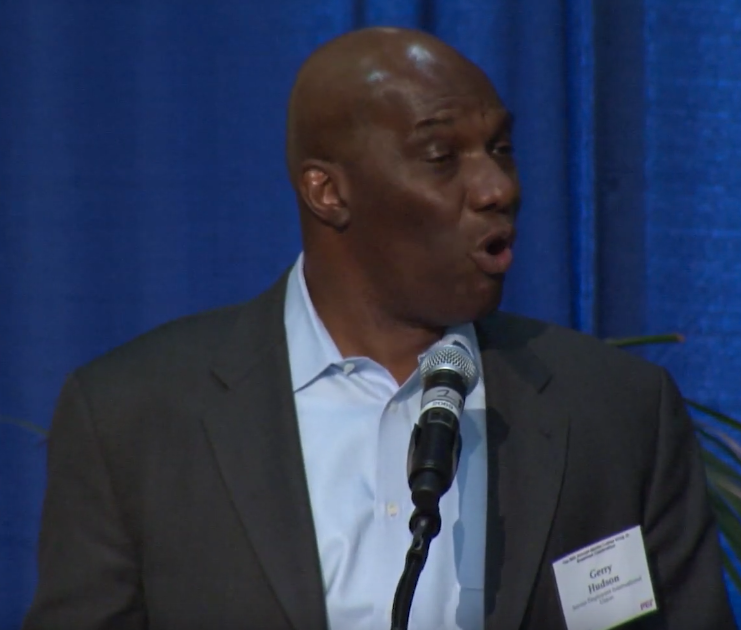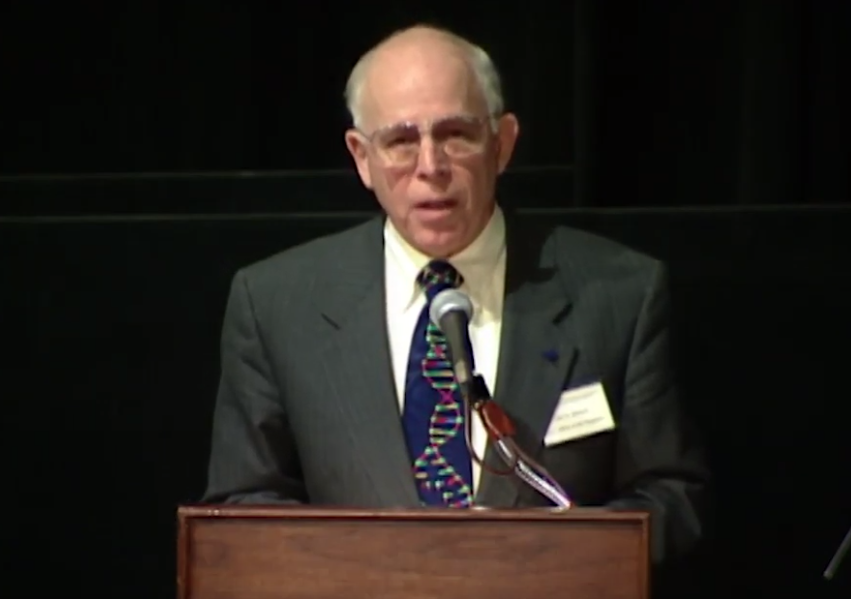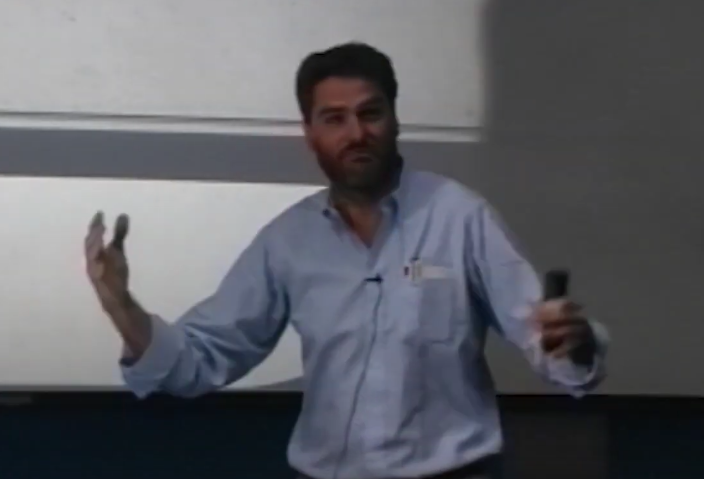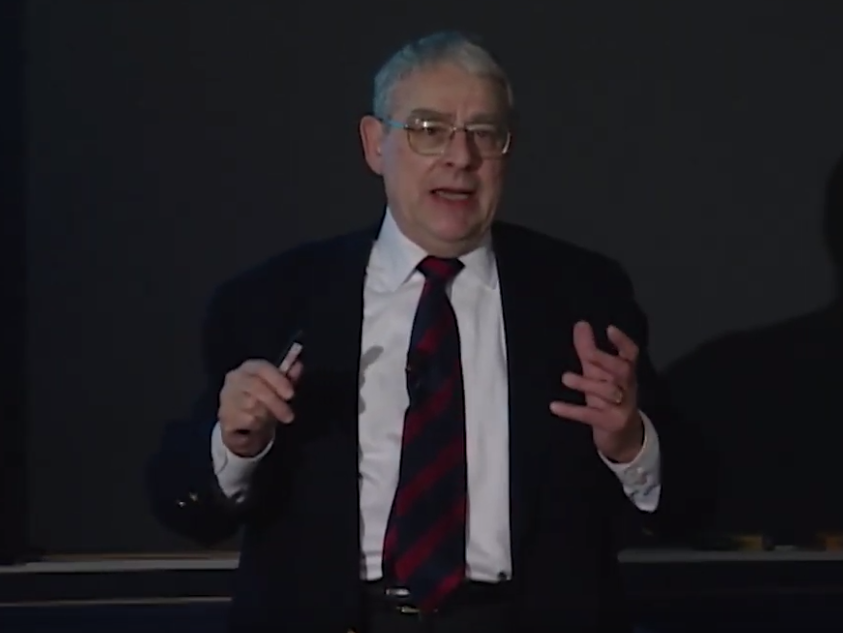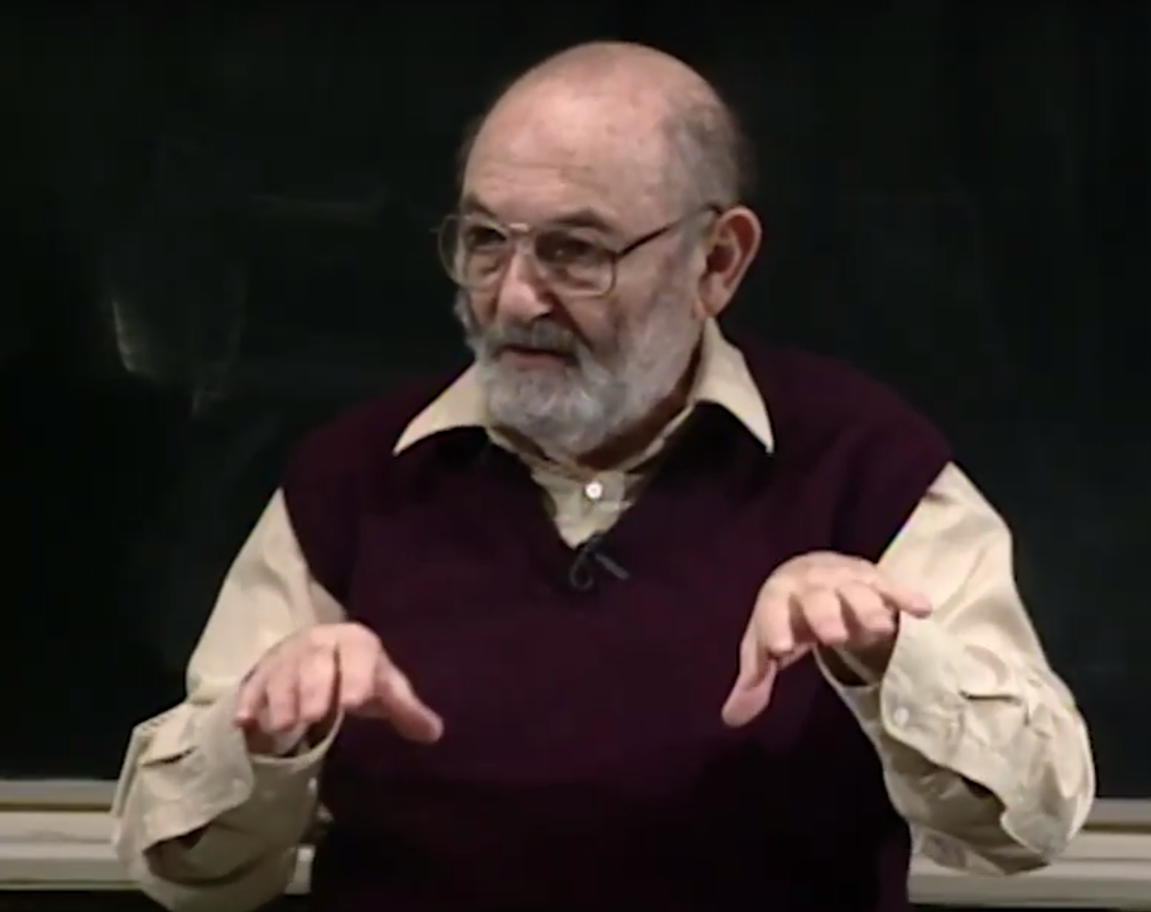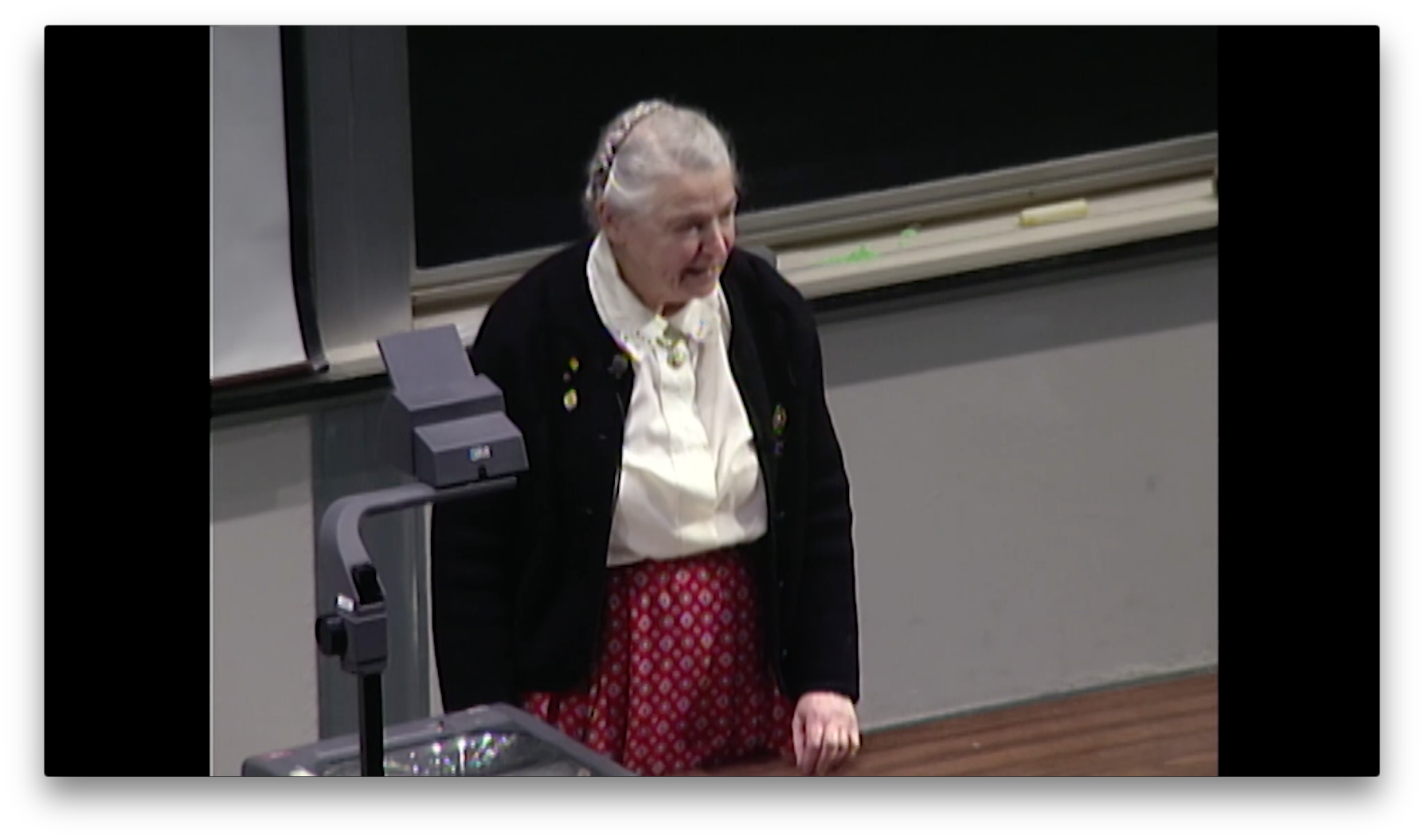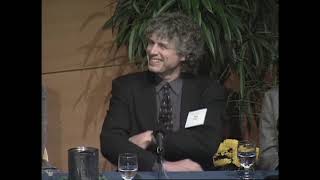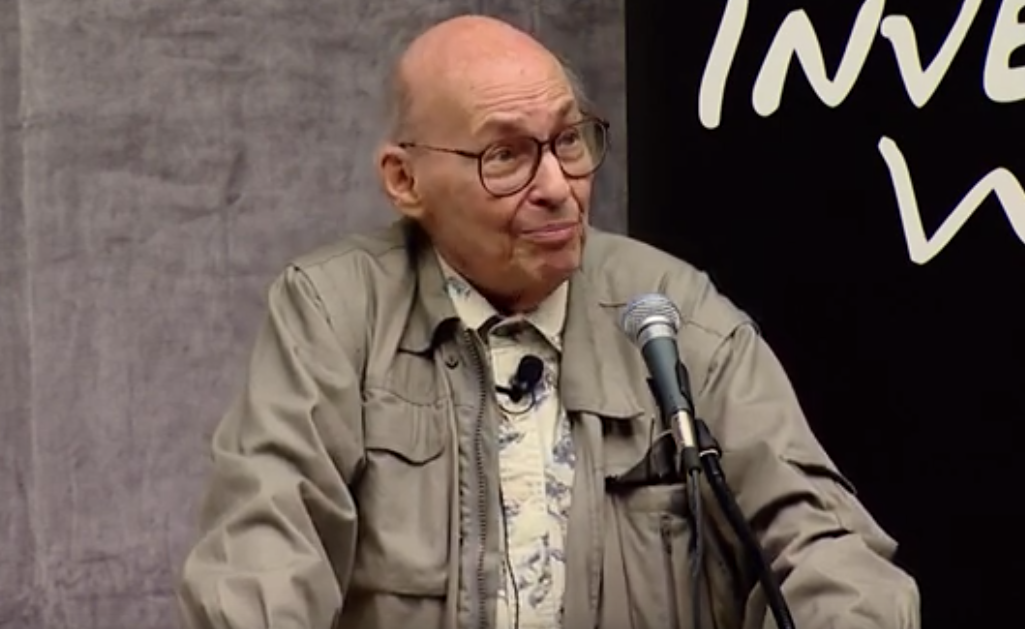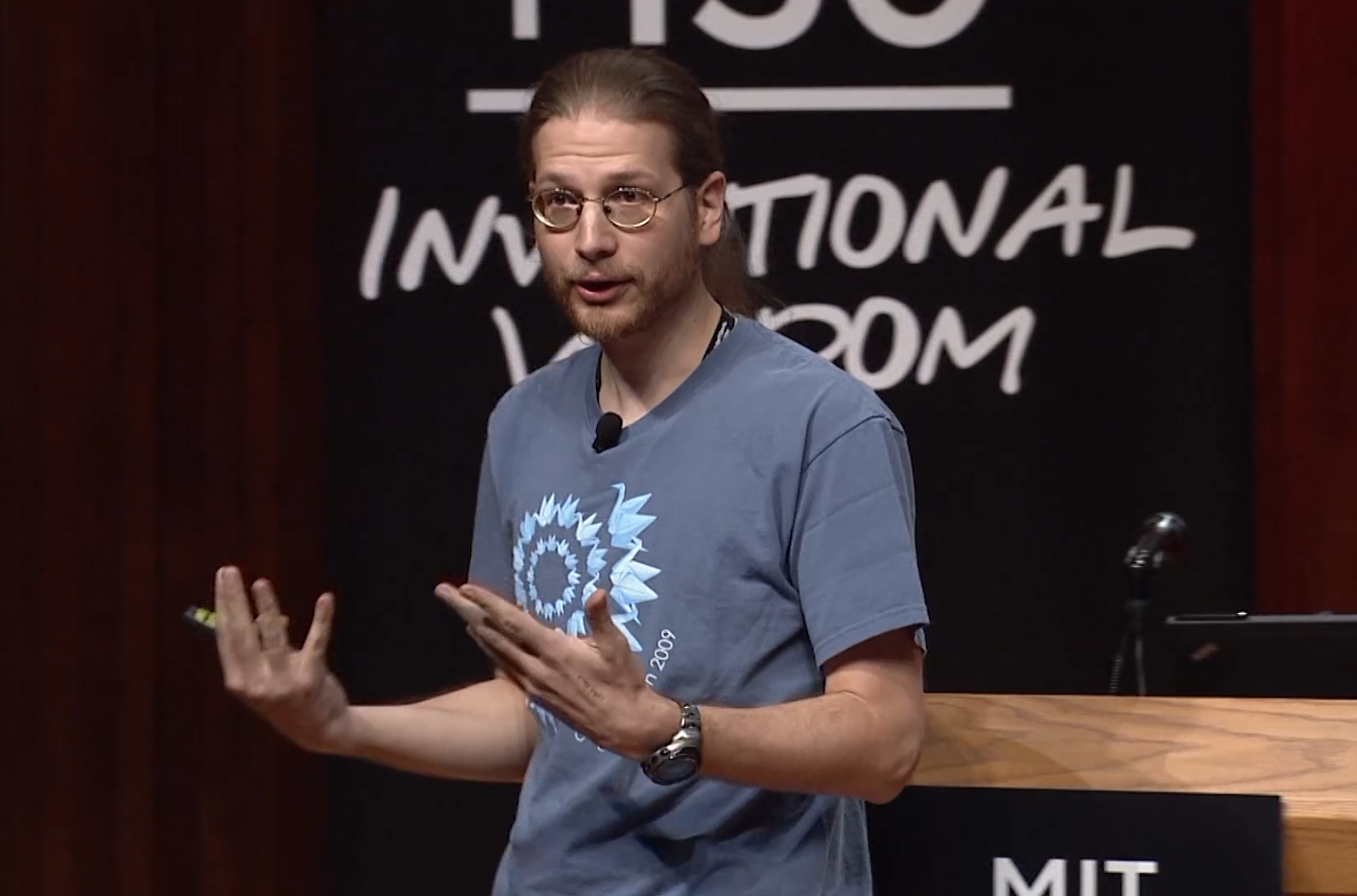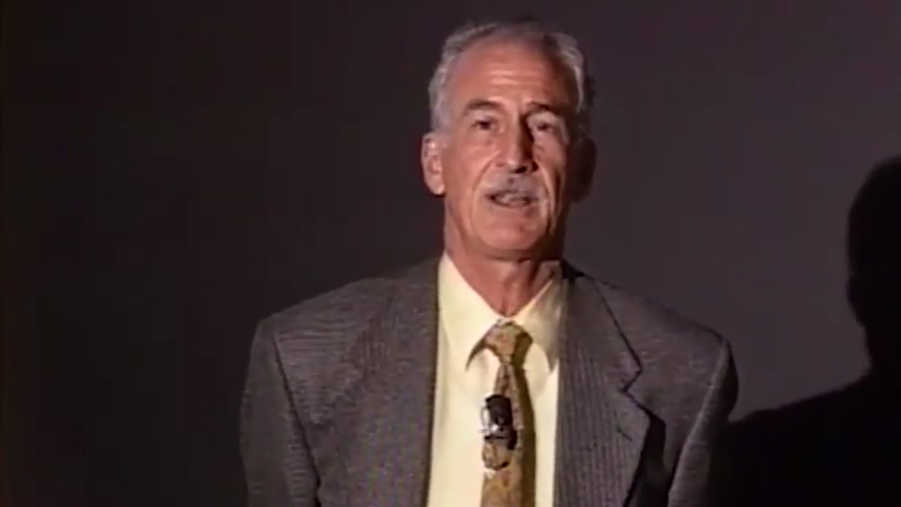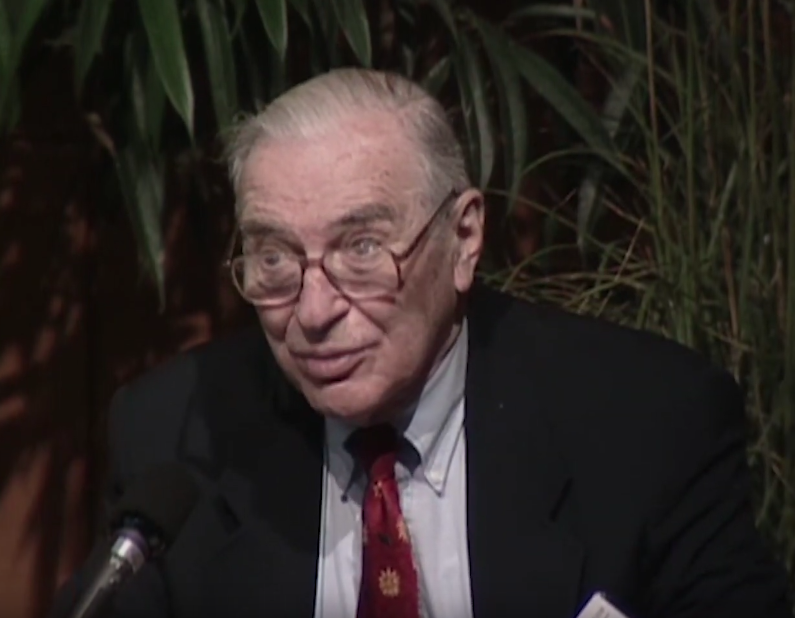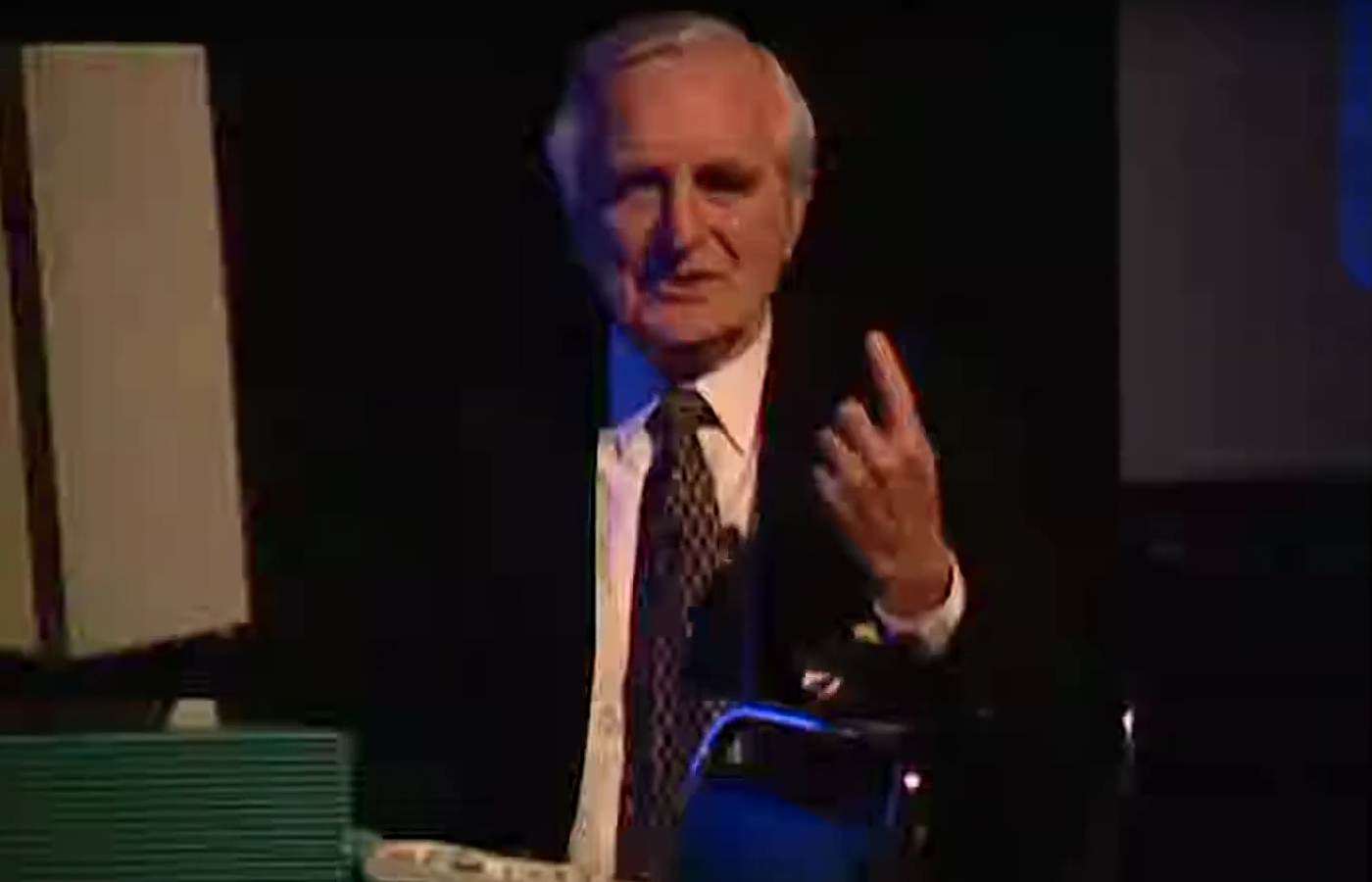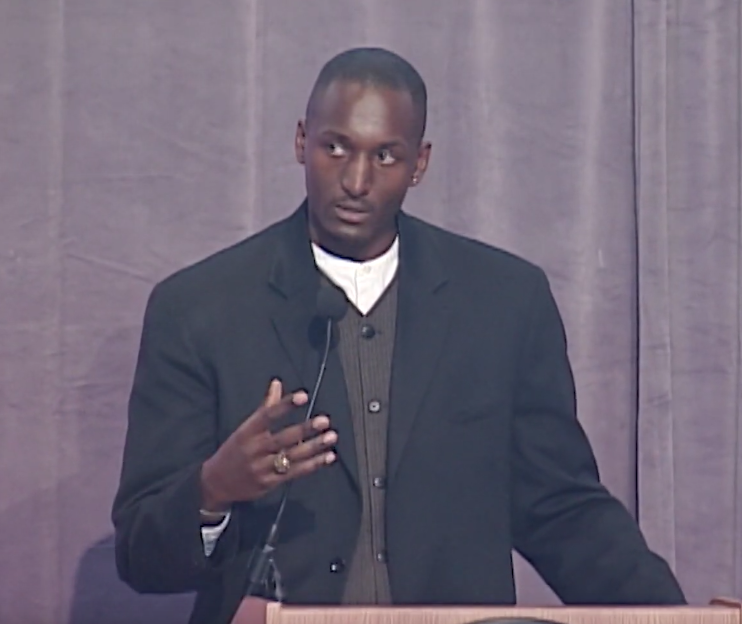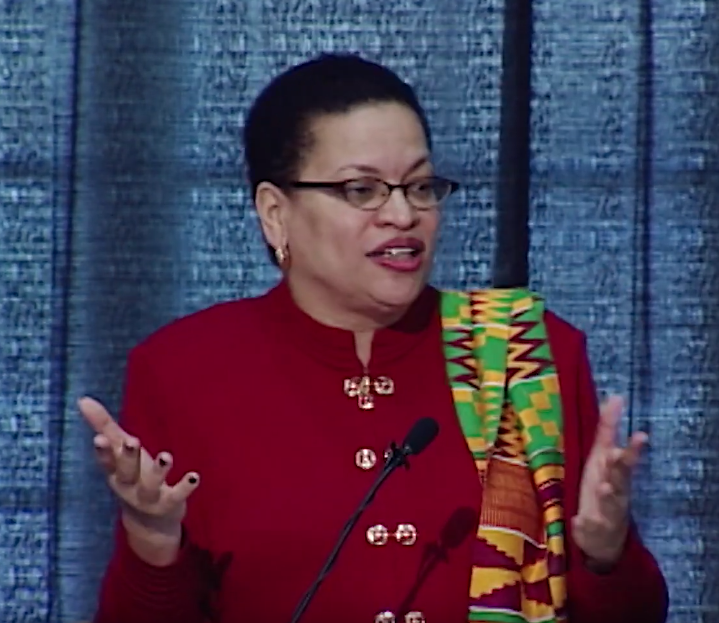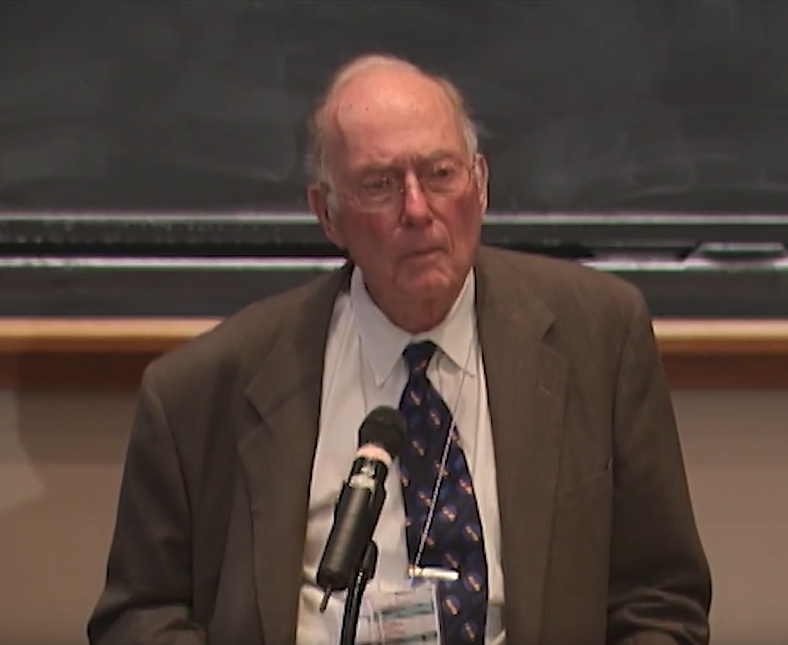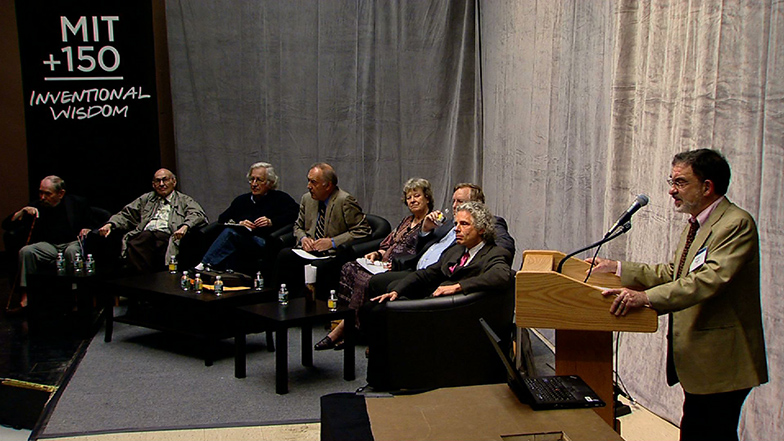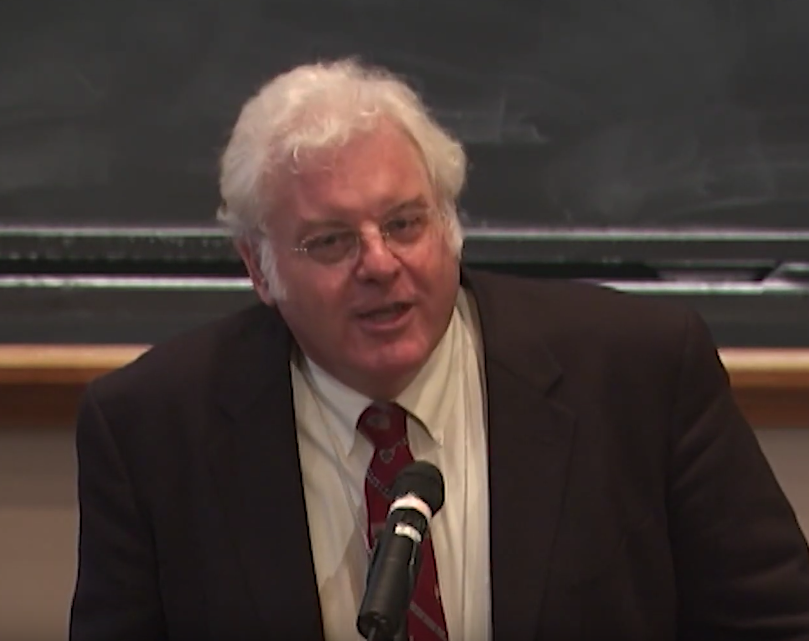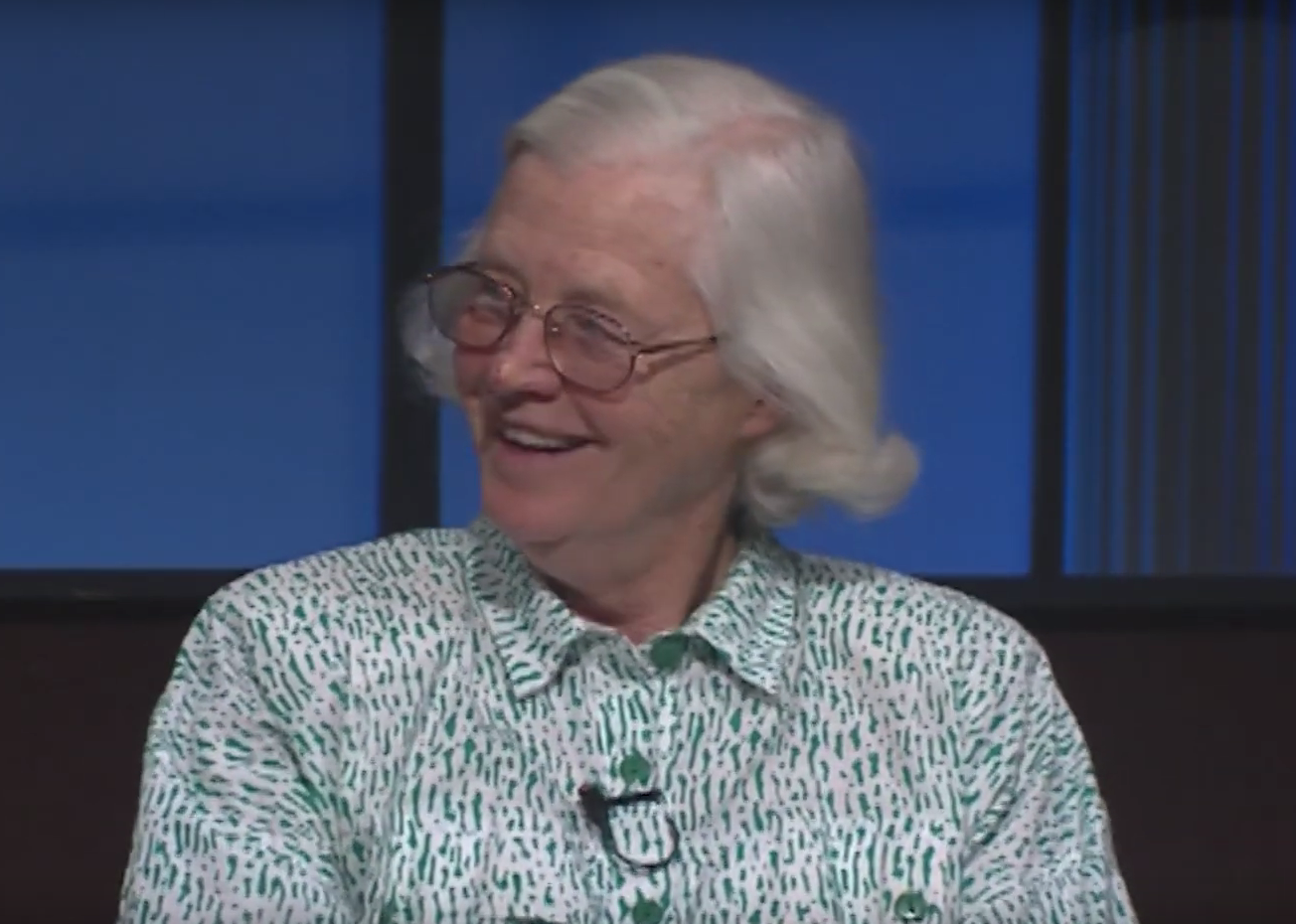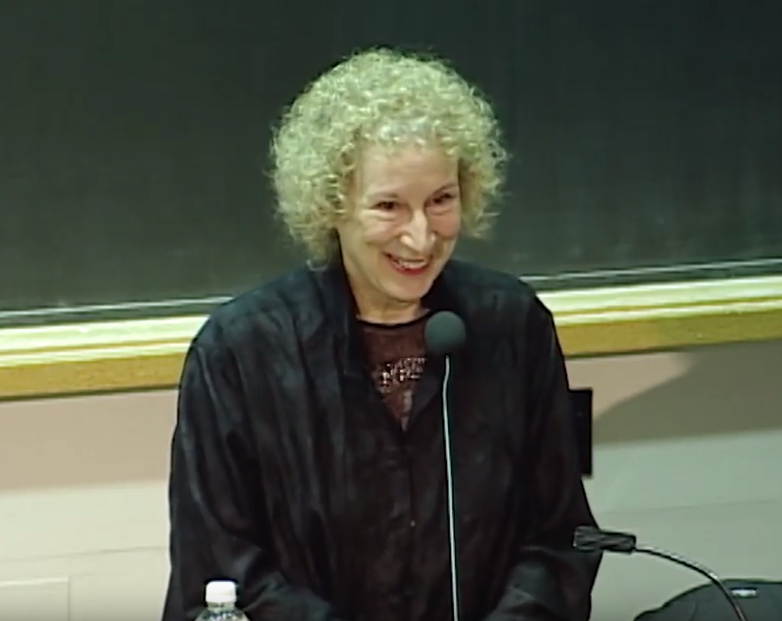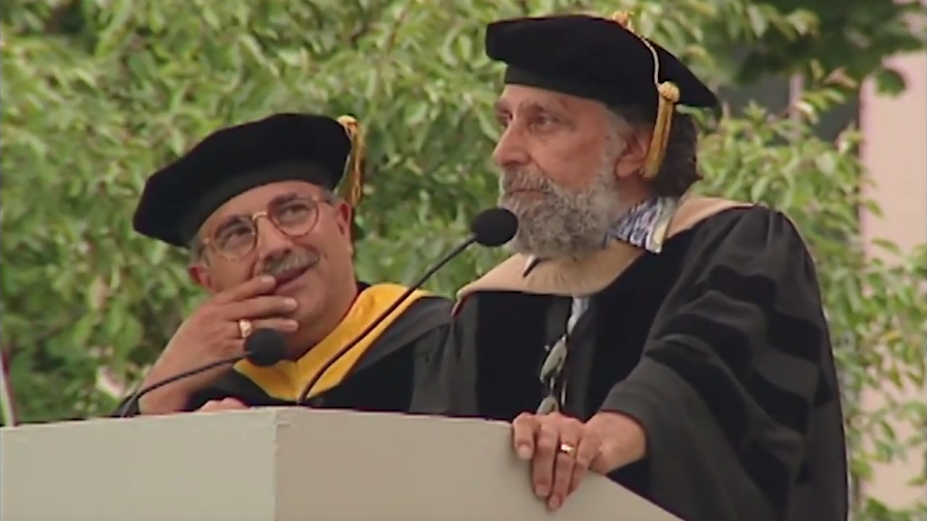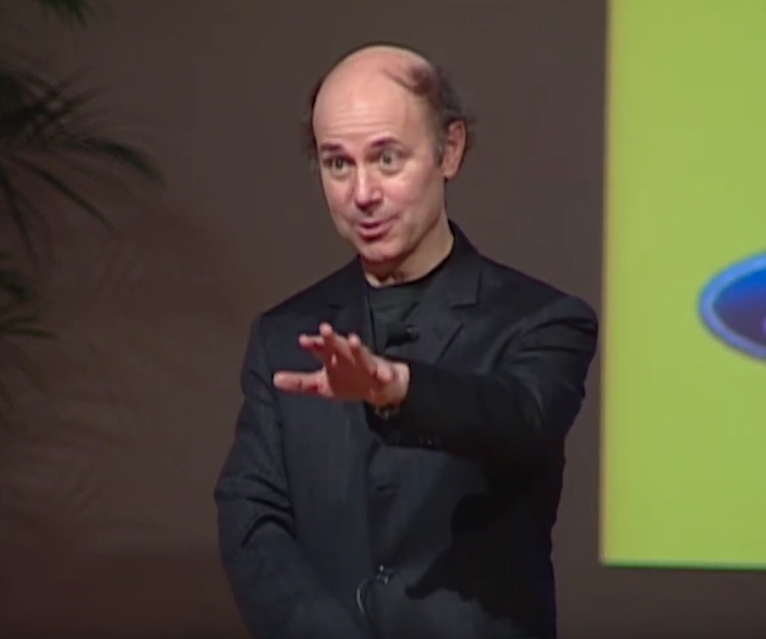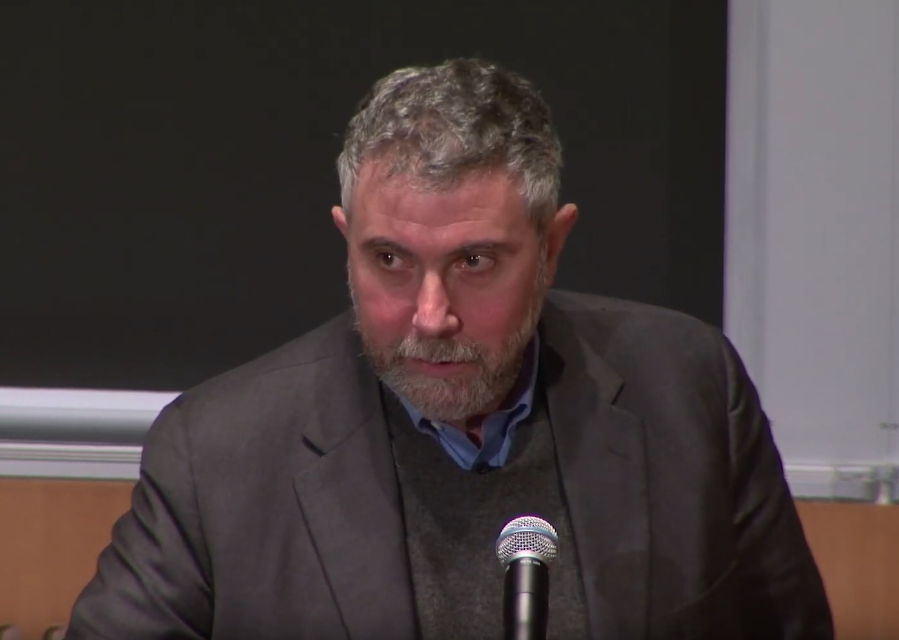John H. Gibbons, "The 21st Century: Science, Technology and Society” Compton Lecture (1/3) 10/22/1998
[MUSIC PLAYING]
VEST: Because our lecturer today prides himself in his trove of interesting jokes and stories, I decided I'd better start off with a joke, Jack. And it's one that does have relevance to deduction and the scientific method. And it has to do with Sherlock Holmes and Dr. Watson being out on a camping trip.
They were lying there in their sleeping bags in the middle of the night on their backs, looking up at the heavens and crystal clear night and millions and millions of stars across the sky. And Holmes turned and said, I say, Watson, what do you make of all this? What do you think about when you see all these stars? What do you deduce from it?
Watson thought a bit and said, well, my friend, I think it's a message to us. It's there to remind us of the vastness of the universe and the miracle of its creation and to clearly send the signal to us that all those billions of stars out there, as far as we know, we're the only planet with intelligent people and what a special place we hold. He said, what do you make of it Holmes? Holmes said, well, Watson, I deduced that someone has stolen our tent.
So with that, as the 15th President of MIT, it's my pleasure to welcome you to the first of three Karl Taylor Compton Lectures that will be given during 1998-99. This lecture series was established in 1957 to honor the Institute's ninth president. Dr. Compton held that post from 1930 to 1948. Went on to serve as chairman of the MIT Corporation from 1948 until his death in 1954.
In his quarter century of service to MIT, K.T. Compton led a crucial expansion and modernization of our Institution. In the words of one of his contemporaries, he was instrumental in transforming MIT "from a good, but more or less provincial Institute to an international Institution." At the same time, he provided extraordinary leadership in bringing science and technology to the service of our nation during the Great Depression, during World War II, and in the critical early years of the Cold War. He served in a variety of senior governmental positions, including Chairmanship of the Depression Era Science Advisory Board, Chief of the Wartime Radar Programs of the Office of Scientific Research and Development, and the first head of the Research and Development Board that was created by President Truman to oversee scientific preparedness in the years after World War II.
These lectures were created as a fitting memorial to Karl Taylor Compton's ability to bring the innovations, the values, and the wisdom of science, technology, and academic inquiry into the arenas of public policy and popular discourse. The purpose of the series is to give the MIT community an opportunity to hear from, meet with key leaders who are helping to shape and inform global events. Sponsored each time by a different academic department, the Compton lecturers have brought a distinguished array of global leaders to our campus. Past Compton Lectures have included statesmen like Hubert Humphrey, former Japanese Prime Minister Nakasone, and they have included Nobel Laureates such as Niels Bour and Linus Pauling. Indeed, last year's lecture was both a statesman and a Nobel Laureate, Doctor Oscar Arias Sanchez of Costa Rica.
This year's Compton Lectures are sponsored by the Political Science Department in conjunction with the Office of the Provost. They have brought us a speaker who is well qualified to carry on in the tradition of his distinguished predecessors. Indeed it would be difficult to find someone who better epitomizes K.T. Compton's own devotion to the development of science and technology, as instruments of national service in the public interest.
Jack Gibbons is an internationally recognized scientific leader whose early career specialty was nuclear physics. After earning his doctorate at Duke, he spent 15 years as a researcher at the Oak Ridge National Laboratory. Beginning in 1970, his professional focus began to shift. He undertook pioneering work of the use of technology in conserving energy, as well as in minimizing adverse environmental impacts from energy production and consumption. At the start of the nation's first major energy crisis in 1973, Jack was therefore well-positioned to become the first director of the Federal Office of Energy Conservation. After two years in that post, he returned to Tennessee as head of the University of Tennessee's Energy Environment and Resources Center.
In '79, he was called back to Washington to direct the Office of Technology Assessment, the OTA, an independent professional agency that provided Congress with nonpartisan expert analysis on a wide variety of issues involving science, technology, and public policy. After two 6-year terms as head of OTA, Jack was selected by President Clinton to be the assistant to the President for Science and Technology and director of the Office of Science and Technology Policy, job he performed with great distinction until he decided to step down early this calendar year. In his role as the president's Science Advisor, as in so much of his career, Jack Gibbons has been a forceful and effective advocate for the importance of understanding and using science and technology, programs and policies designed to address larger public issues.
Several of us from here at MIT, myself included, greatly enjoyed the pleasure of working directly with Jack through our joint service on the President's Committee of Advisors in Science and Technology. Through that close professional association, we have come to appreciate that Jack is exactly the kind of scientist that President Compton found so valuable and virtuous. He's a leader not only in his own field, but in the complex and demanding business of bringing science and technology into the mainstream of public discourse and policy making. Jack's most recent book is entitled This Gifted Age: Science and Technology at the Millennium.
His lecture for today's entitled The 21st Century: Will Science and Technology Contribute to Society or Scuttle it? His second lecture which will be delivered here at the same time on Monday, November 30, bears an equally provocative title Governance of Science and Technology: Theory, Myths and Reality. I think I know how he will answer the question in the title of this day's lecture, I have no idea what he will say in November. But please join me in welcoming an outstanding colleague and good friend, Jack Gibbons.
[APPLAUSE]
JACK GIBBONS: I think I have my mic on. Is that right? Good. President Vest, how indeed nice it is to be with you and to come to MIT in this capacity. I'm greatly honored by the invitation. And I look forward to the weeks and months ahead, and working with individuals, and departments, and programs, as well as these several Compton lectures. I want to especially thank Chuck Vest for taking the time to introduce me, he doesn't have very much to do, of course, as you understand.
Chuck, when he came to MIT, was also very, very generous in his time with a lot of issues we had to deal with in Washington. And I don't know whether his wife has forgiven me yet, but I remember on one occasion in which he was helping try to figure out what in the world to do with the space station back in 1993. And I think his last night on that project, he worked not only through the night but saw the dawn and sun come up the next morning while he was still trying to finish that work up for the president. I think that's first time that had happened to him since graduate school. But I want to, in case you don't know, I want to congratulate Chuck in public for the fact that he's now a grandfather. You don't look it Chuck, but we're very proud and happy for you, and for Becky.
It's no accident my coming to MIT, I yearned to come to the place that I saw as a symbol of the front edge of higher education and research in public service in terms of science and technology in our nation's future. There's no question in my mind what MIT carries the leading flag in that regard. And I'm, therefore, feel a little bit like carrying coals to Newcastle to talk with you about these issues. But nonetheless, bear with me and you can attack me when I finish my lecture.
I do, in this first lecture, want to say that I'm drawing on not only my past work at OTA and the Office of Science and Technology Policy, but also to a degree in my prior experiences in research and in technology development. The course now, I'm out of government and I have changed my pace. My office is now on the farm in northern Virginia, a comfortable hour away from downtown Washington.
And in setting up shop at home, I had to get a computer set and a lot of other things going on. So I got some advice call a Farmer's Guide to Computers. And there's several definitions I thought I would share with you. To log on means making the wood stove hotter. Monitor means keeping an eye on the wood stove. Download means getting the firewood off the pickup truck. Floppy disk means what you get from piling too much firewood up. And windows means what to shut when it's 30 degrees outside. And finally, mainframe is what holds up the barn roof.
So if you have to remember to get your term straight, even though the words may be identical, the meanings are different in one setting versus another. But thank you so much for inviting me to be with you during this 1998-99 winter season. The title I conjured up for the talk is a teaser, you know it. It's not either/or, it's always both.
Robert Lewis Stevenson said that nature never gives anything to anyone, everything is sold at a price. It is only in the ideals of abstraction that choice comes without consequence. Alvin Weinberg talked about nuclear energy in terms of the faustian bargain. If you want to take the powerful opportunities of nuclear energy, you also have to make the bargain of stewardship. And because technology is the human use or application of knowledge, and because humanity always displays the passion for both good and evil, there's no question but what powerful technology will add either to the benefit of humankind or to its detriment, depending on how humans use it.
And in thinking about this question of the 21st century and the role of technology, I had a few images flash across my mind. First of all, national defense these days is certainly governed by the fact that we have the science and technology edge that we have obtained since World War II. It is an enormous asset for us in terms of providing an assured national security at a much lower investment of people and money than otherwise would be required by virtue of having front of the edge technology. The food we eat, the drink we drink, the shelter over our heads, the interior lights, and the illumination, and the heating and cooling, all of these things are direct results of technology that would have been the envy of [INAUDIBLE].
Disease these days is not exactly on the retreat, but we're certainly gaining in terms of the ultimate goal of, as one physician described to me once, having people turn into alkaline batteries. You know, an alkaline battery runs, and runs, and runs until it just suddenly dies instead of petering out like a carbon based battery. And he said that's our objective for humanity, we should turn people into alkaline batteries. And I think we're doing a pretty good job of it, given the extension of useful, active, healthy lives that come about by virtue of technology and medicine.
Job increase has been enormous, because of the opportunities provided by advancing technology for people to use them themselves in very productive ways. Transportation is beyond belief of my father even, much less my grandfather. Communication and access to knowledge is beyond the belief of people who thought about this only 20 years ago, before internet had its exposion and the opportunities now in this latter day succession to the invention of the printing press to have access to knowledge from whence commerce power and influence. Environmental wastes is another area where we have made extraordinary gains. Let me give you an example.
This first slide I took from a magazine some years back. I think it was advertising sewer treatment. But can you imagine our cities today without the capability that technology provides for gathering, and assimilating, and treating wastes that otherwise would make urban living simply impossible. The convenience and amenities provided by technology are essentially too numerous to mention. And I think Oliver Wendell Holmes captured the positive spirit of science and technology when he wrote the following. Holmes wrote, "true science knows no bounds. It penetrates into every domain without fear and it serves all men without prejudice or favor. Its work is to substitute facts for appearances, demonstrations for impressions, and beneficial realities for those many things that ignorance and greed proclaim to be impossible. For suffering humanity," says Holmes, "it is hope and promise."
Now, I could spend all day talking about the goods, but as Ken Boulding always said, you should also talk about the bad, because that's the other side of the coin. And in my thinking about today's talk and where we are now, I thought about just several things that I think we should admit to. First of all, that technology has led to the proliferation of weapons of mass destruction in a form and scale never before witnessed on the face of the Earth, both nuclear and biochemical weapons. Their use not only by nation states but also by small terrorist groups now makes the world a very different place and security a very different thing from what it was a scant several decades ago.
Population growth has been extraordinary, driven by the fact that health has brought death control downward and birthrates remain high. And the consequence of the difference between those two functions led to a very rapid increase in world population.
For example, when DDT, after post-World War II, was introduced into Sri Lanka, death rates fell by a factor of two very suddenly. And the population of Sri Lanka doubled in 17 years. This is a benefit of death control but the disbeneift of having a sudden imbalance between two things that only slowly change.
And it's not just numbers. It's an issue of quality of life that goes with population. And this is another ad from a, in this case, newspaper. Who wants to go to Jamaica in the summer when you have the beach right here? Well, these are people. And I think the ocean starts about here. But you can see the problem illustrated by this, namely that we have, in terms of quiet, empty spaces for those uniquely human functions of population in many ways is already outstripping our resources.
See how this works. I'm going to run back over to the podium. Along with a population explosion and the press on people comes also a loss of privacy. That is a child of some our modern technology, derived through information technology's expansion and such things as DNA typing, which now give us different and additional reasons to have to apply governance to the use of these technologies in order to assure traditional freedoms of choice and of privacy. This is going to be a matter of continuing and increasing concern. If we want the benefits of advances in information technology and molecular biology, we also must, along with that, join with public policies that help assure our traditional freedoms that can be infringed by the misuse of that kind of a technology.
Our environmental losses have been large. We have lost some species at an increasing rate. The Chesapeake Bay oyster yield is now 1% of what it was 100 years ago. Zebra mussels now cost us nearly $7 billion a year in management costs in the US alone. We are doing things with our atmosphere on a global scale that I will return to in a few minutes. In other words, we have some bads that come along with the goods.
And we have rising conflicts between technology and its use on the one hand and traditional ethical and religious and cultural values. This is perhaps personified by the great writer and anthropologist Loren Eiseley, who made this exclamation in his book, a book called The Firmament of Time. Eiseley, I think, personified the frustration that a lot of people have about technology, and it's kind of tough to read. But I think it's important for those of us in technology to understand this feeling.
Eiseley says, it is with the coming of man that a vast hole seems to open up in nature, a vast black whirlpool spinning faster and faster consuming flesh, stones, soil, minerals, sucking down the lightning, wrenching power from the atom until the ancient sounds of nature are drowned in a cacophony of something that is no longer nature, something instead which is loose and knocking at the world's heart, something demonic and no longer planned. Escaped it may be, spewed out of nature, contending in a final giant's game against its master. Those are tough words from Eiseley. But I think they very poignantly point out the frustration that many people have about the way things are moving under the influence of advancing technology.
Most recently, Pope Paul, just this month on the 20th anniversary of [INAUDIBLE] encyclical warns about science and technology progress as putting humanity at risk. And I think that while that's true, that's but one side of the coin. And I'm afraid that it's up to us to make sure people understand that with every powerful idea, including technology, one has the power both for good and evil.
So what lessons do I draw from this litany? First of all, the power of free and open society, of open markets, and seed ground for innovation such as we find in our country provides for efficiency. There is a concomitant need, though, to manage externalities and to assure level playing fields. But there is an enormous power never before witnessed in terms of creativity and its influence on the way people live and their options and opportunities that derive from technology.
The second observation or lesson is that the power that science and technology have to provide brand new options to do things, to achieve goals, to provide for our wants and needs, both the goods and the bads, but you can't have one without the other. The third observation is this extraordinarily pervasive and growing dependence that humanity has on science and technology for its livelihood and its future. Fourth, the stresses imposed on societies and social institutions by the high and even accelerating rates of change driven, of course, by science and technology change. And the results of this can be seen in so many ways, the rise of neoconservatism, of creationism. A lot of other, as it were, retreats, I think, are outward examples of the concern people have about this almost intolerable rate of change that they seem to see being imposed upon their traditional thoughts and values.
And finally, in terms of observations from this litany of the recent past, in general, I think the dynamics of exponential expansionism are catching up with us. The exponential has for a long time been the surrogate for progress. As long as we can grow, things can get better. Growth measured by way of the extent to which we consume raw materials.
I reserve the word growth. I'd rather call it expansionism because growth can mean different things to different people. But this 20th century paradigm of growth through expansionism, of the exponential being our salvation, I think, is now anachronistic.
Robert Heilbroner, who is a, I guess, combined sociologist and economist, Chuck, if I remember right, wrote recently that the coming generation, he said, will be the last generation to seize control over technology before technology irreversibly seizes control over it. A generation is not much time, he says, but it is some time. And that's pretty serious business to say that somehow technology as an external force somehow from society has that kind of capacity and power. And I think it confuses technology on the one hand from ourselves on the other. And I think we need to concentrate and understand, though, the feeling that arises in people who would make statements like that.
Well, what about the 21st century? That's what I came here to talk about. But you can't look ahead without looking back a little bit. I would make several observations about the 21st century. First of all, I don't think there's any end in sight for discovery or the development of new options. Every day tells us that we're still, if anything, on an accelerating pace of discovery.
Lewis Thomas said before he died that he thought history would show that the greatest discovery of the 20th century was the discovery of the extent of human ignorance. And I think that may well carry over to the 21st century. But it certainly is an apt statement about the extent to which knowledge is constantly an unfolding phenomenon. And that will happen right straight on into the next century.
The second thing I would say is that our economic market basket is growing and will continue to grow but that the contents of the market basket are and will be shifting depending on how we go about providing goods and services for the people's wants. There is no apparent limit, as far as I can tell, to greed or avarice that seems to be in our genes somehow. But there is indeed some hope and some evidence that we're beginning to think more carefully about what we mean by growth and progress.
For example, one statement that is very appealing to me is that there is a big difference between being rich and being wealthy. Being rich, on the one hand, is making lots of money. Being wealthy is having lots of time. And I think that notion of trade off between money and other desiderata is something that we may well want to pay more attention to in the coming century. And maybe technology will help us get there.
Third statement about the 21st century is that our global problems are indeed looming up on us. And I think it will be a century in which we will have to become constantly and ever more carefully thinking in global terms and linking our local actions to global actions and our actions now to events and actions in the future. Population is growing. We hope that the 21st century will exhibit a leveling off or at least a tendency in that direction of global population.
We know our atmosphere is becoming markedly changed by human activities. And I'll return to that in a few minutes. And we know that our biosphere is being significantly impacted globally by human activities in terms of diversity and depletion of species and the loss of habitats. As a consequence of some of these as well as other things, social stresses are indeed amplified. And as I said before, religious fundamentalism, economic frustration emerges from these kinds of stresses and can result in violent conflict.
And in terms of global problems, deadly conflict and terrorism is certainly not new in the world. But it is more intense and more deadly with the modern technology. There is indeed no hiding place now anywhere over the globe from this kind of frustration exhibiting itself in terrorism. So just as economics are now globally tied and integrated, so too is environment and security.
Now the thing that strikes me is that many of the biggest challenges presented to us, population, climate change, biodiversity, have large hysteresis in them. And they present conflicts of time constants involved. In other words, they seem to develop fairly slowly as measured in terms of political response and the attention gotten by the public. And at the same time, many of them are nearly irreversible or even completely irreversible in the future. So there's not a symmetric oncoming and outgoing. There is a hysteresis in the process.
And that presents some real problems. Adlai Stevenson once observed that American people never seem to see the handwriting on the wall until their back is up against it. And I think it's probably a truism. It's not just American people. It's generally people have that feeling. The closer to them personally or in their backyard, the more attention it gets.
And global biodiversity change, global climate change are not things that, at least superficially, present a lot of handwriting on the wall until our back is up against it. And Mario Merlino knows all about-- hi, Mario-- knows all about that. And the question is, how can you take such an enormously important thing, the planetary commons and transform it from a Never Never Land way down the road, therefore, I'll forget about it to an issue that is perceived and interpreted as something of immediate concern to us, immediate long-term rational self-interest concern?
Most of these issues lie outside the traditional marketplace. They are indeed the so-called global commons. And the problem is that we are now treading on the global commons to the point that it's not a free good anymore as we used to think. I remember when I was a kid. Chuck, I'm older than you are. But I remember when I was a kid, people would say, what do you mean? It's a free country, ain't it? And free country meant, in those days, it's a linear country. If you get into trouble, you just need to move a little bit farther away from your neighbor. It had no sense of that kind of interconnectedness or non-linearity that now is reality for all of us.
Well, what's the point? The point is, I think, that was sufficient lead time, and I would proffer this, with sufficient lead time, many, if not most of these issues that I've spoken about can be addressed using ingenuity with science and technology. But we need the political will to do so. We need to catalyze a political or public will to take action on issues before our back is up against the wall.
There are some successful lessons. I think you all know about stratospheric ozone as a good recent example of a successful lesson in this regard in which between Mario and some other people, they finally understood what was happening in the atmosphere and were concerned about certain manmade chemicals affecting the thickness of the stratospheric ozone layer, which in turn protects life on the Earth from ultraviolet rays from the sun. And people began to worry about what other kind of chemicals could be used for refrigerants and the likes that didn't have this unhappy property.
And so they began working along and the chemists came up with some wonderful technology substitutes for these unhappy, these molecules that are triggering the destruction of stratospheric ozone. Industry understood that this was a market opportunity and that they could substitute one for another. In fact, there were some substitutes for the chlorofluorocarbons that were cheaper and more effective than the chlorofluorocarbons.
And just as we were trying to form a public policy to collectively have all the world's nations work on getting this stratospheric ozone protection up, along came the observations of these enormous holes in the ozone in the Antarctic. And the explanation related back to human activities. And to me, it's still a wonder because I've been to the South Pole to look up into the heavens whether it be in Boston or in McMurdo Sound and see this enormous atmosphere up there and know that it is being materially affected, specifically by human activities, for the first time since humanity came about. But it's a good example of where we did as a world of nations find a technical alternative, institute some price changes, which pushed the market in the right direction, and put in place a process whereby within about 50 years, 30 to 50 years, we will find the ozone depletion dropping off and moving back toward greater protection. But mind you, it'll take about a half a century before we really see significant improvements in that erosion, a long time constant.
Another is the Clean Air Act, which as you know was passed with great trepidation because there was concern about the cost of cleaning up the air. The estimates turned out to be about 10 times more costly than the actual facts of the matter. Now why did the facts of the matter end up being so much less costly in cleaning up the air? Two reasons.
One was innovative technology. And the second was to institute trading of clean air rights. So that those who could clean up the air least costly were able to sell their capabilities to those that were emitting pollutants but it was too expensive to clean them up. So by trading these emission rights, where they were able to go the minimum cost path for the improvement in air pollution, and we ended up with about 10% of the original cost estimate to do the job that was needed. We're going to need some more of that in the future. But it's another good example where collective action can work.
Well, what about the future then? C.P. Snow once said, incidentally, that a sense of the future, and that's what we're here today to talk about, a sense of the future is behind all good politics. Unless one can have it, one can leave nothing either wise or decent to the world. It's really incumbent on us just to have the commitment to think about the future, not to know where it's going, but have a sense of where it may be going depending on the actions we take between now and then.
As Al Gore has frequently said, the thing about doing for the future is to do it smart and not do it dumb. And we know ourselves that we've done some dumb things in the past. And we hope that we don't repeat those in the future and that we can pass on some of those lessons to the third world. Doing things smart means using elegant and thoughtful technology.
Some of those examples, I would like to mention to you. One is the term sometimes called green manufacturing, others, industrial ecology. It's a very simple thing in principle. Elegant in practice and making its way now especially in Europe but also in the United States and the other advanced industrial countries.
The old method is to simply take a linear flow of materials and products and waste streams. And the newer notion is to integrate all the way across from the initial design of a product to its ultimate disposition and use of the materials. And in doing so, make a materials choice at the design end that's going to make the tail end of the system work a lot better. In other words, put a bubble around the entire production process rather than segregate these off into different parts.
A good lesson early to me in Tennessee was coal strip mining. Where the mining people used to just strip off the dirt, dump it down the hill, mine the coal, and then either leave or come back maybe and push some of the dirt back. That was very expensive and not very effective because they separated the recovery or restoration process from the mining process as though they were two different things. Then they began to realize that if they would integrate these two processes together and make recovery part and parcel of the mining process, they could do a more effective job.
And that's what's caused now the ability with full integration of the ultimate recovery and use of the land an integral part of the mining process. And it has resolved a lot of problems in the coalfields. The same generally in manufacturing, I think, is a very important idea to be going in. And we're making some good strides.
The second is in the transportation sector as an example. We now have, even though petroleum's prices are lower than they've ever been, we are making good progress on being able to use fuels for transportation, for instance, in automobiles at perhaps three times the efficiency of present automobiles with the same degree of comfort and safety and attractiveness. And this has so many public benefits as well as private benefits that there is a consortium of government and industry working together over a 10 year period to push the technologies ahead to the point that this can be a practical reality, a substitution, therefore, of elegant technology for what we used to have in the past.
As a consequence of that kind of work, you can devise the following sort of future scenario, this is time versus millions of barrels per day of oil for the United States. And the green is domestic production. The red is net imports. And the yellow line at the very top of the envelope is future demand for-- domestic demand for petroleum in the transportation sector. And you see if you introduce over time improved technologies simply for more efficient use of energy and also for alternative and supplementary fuels, you see what can happen. You can move from our domestic oil production upward by additional fuels from Alaska plus some alternative fuels, for example, from biomass and other domestic sources. This cuts into the net imports from the bottom.
And then one can lay in different scenarios of introducing efficient automobiles and trucks into the fleets so that the energy demand drops even though the expansion of transportation continues. This means one can move from an envelope of domestic consumption like this and very large imports down to a point that we could have imports that would be at almost a level amount by the time we get to between 2010 and 2020, which may well be a very important time because that's the time in which the demand from the emerging nations, India, China, others, will be having a much greater call on global petroleum availability. And this will help ease the pressure on global availability of petroleum.
An example, therefore, of long-term capital stock turnover, where the property of the capital stock is to provide that good or service with less energy intensiveness. Along with that in the 21st century is the undoubted question of how we move toward the next cycle of primary energy availability in the globe. These are cycles historic up to here of the dominance of wood and then coal and then oil and now very shortly natural gas. And that pattern continues on to about the middle of the coming century, during which nuclear and other advanced forms of energy are going to undoubtedly have to begin to make their play in the market. And how that divides out between different energy sources, or I call it energy sorcery, depends a lot on where technology takes us in the interim. But it's going to be an interesting half century.
Incidentally, historical context, look what's been happening to the carbon intensiveness of energy. This is a global plot. It goes from about 0.85 down to about 0.55 between 1850 and the year 2000 as a result of that substitution of moving from coal to petroleum to natural gas. So the carbon intensiveness of our energy system has indeed been changing quite steadily. And that's to our credit. And we have more to go. But it's going to get tougher as we move on out into the 21st century.
In biotech, we have an enormous opportunity. As the president said, this may be the century for the life sciences where the 20th century was the century for the physical sciences. I can't separate them out that well myself. it's Harold Varmus said, medicine would be almost nowhere now if it weren't for crystallography and x-rays and all sorts of fancy physical techniques in order to do research and to carry out medical procedures but an age of science.
And biotechnology in terms of its impact on health, including its more effective means for birth control, especially for the developing countries, and biotech for food production will be enormous and important. And I think the challenge is full of opportunity for the coming century. In a sense, it'll be a molecular level succession to the green revolution in our food sector if we do it right and do it carefully.
In information technology and its impact on education and learning on worker productivity, on efficient use of resources, including energy and materials, enormous opportunities still lie ahead of us as we move more deeply into the age of information. And it's very difficult, as you know, to predict where things are going to go when things are changing still so very, very rapidly. But that just simply tells you the opportunity is there both upside and downside.
And finally, in weapons, I have to say that the opportunity now for the sequestration of nuclear weapons materials has never been greater. Things are happening pretty rapidly now. But we can ill afford to wait or slow down. The disposal of plutonium is a challenge but a lot of opportunities for doing things if we set our minds to it.
The use of technologies for effective national technical means of verification and monitoring are very important. As nations who don't necessarily trust each other must learn how to work with each other in terms of being comfortable about what the other country is doing. That all depends very deeply on technology development and the use of existing technology.
And there are some downsides. I'll give you four quick examples. One downside is proliferation of all sorts of weapons and methods for doing ill. It does go beyond nation states to individuals. And on top of this, I'm, frankly, personally very concerned about the talk of weaponization of space. That simply would open up in the name of somehow building a magic shield over our heads, which won't work, a way to spend a whole lot of money as we did in the '80s for naught. And we simply can't afford those kinds of spare resources. But mark my word, I think there's going to be a big fight in this coming decade in terms of understanding the cost of that impossible dream of building somehow a shield over continental America that will put in space the same thing we used to have for the oceans.
It's essentially an isolationist concept that I'm very much concerned about. Not about battlefield protection, ground-based protection against missiles but about continental wide area protection. Fast way to spend money. I almost lost my job at OTA when I fought the space-based weapons back in the early Reagan years. So I know what of I speak.
And I think another downside is the further loss of privacy, the further inroads to the notion of intellectual property. All of the other downside potentials of this extraordinarily powerful information technology that is going to be our salvation and yet, at the same time, something that will require careful thought on the governance of this extraordinary development. But the slowly changing things worry me even more. Let me speak just for a few minutes about two of them.
First of all, I want to speak a little bit about population. Now I think most of you know about some demographics and the so-called demographic charts of age distributions. This is of male and female to the right and left of zero line simply to show a nearly symmetric function.
And if you look at the United States, this is about what it looked like about five years ago. It hasn't changed that much. Namely, we have a bulge of population in the 20 to 40. That's most of you, isn't it? Here you are in the bulge. And that's partly due to the baby boom and the large number of children being born post-war World War II era and beyond. And then a move back toward a replacement rate fertility rate. And of course, as this bulge moves toward the later years, you run into a lot of problems of Social Security, of jobs, of working people versus retired people, a lot of very important sociological implications of a transient nature of moving from a expanding population to one that is dynamic or static.
Now if you look at Italy, it's almost a vertical line. It's almost distribution straight from old to very young. If you go and look at, say, our neighbor in Mexico, you find this kind of age distribution, enormous number of young people with very few of the very old people, which should make these folks feel better because they have all the young folks to help take care of them when they're old, right? But that can't go on forever because that produces a kind of a population growth that's simply not sustainable.
And China has gone from this now to try to move toward a stable population. And they have that problem of the bulge. And if you try to move that bulge too quickly by decreasing birth rates over time, then you find that you have too few young people entering the labor market and too many old people. So this thing can't change fast. It takes a century or two to make a major shift in the population profile of our countries. It's the kind of insidious slow moving thing that unless you think about it carefully and plan for it over the long term, you can get into a lot of trouble.
I'll show you an example because not doing anything is in itself a very bad idea. Here is southern Africa, south [INAUDIBLE] Africa. And these are not data. These are projections based on population in 1980 of about a half a billion people with three different scenarios, namely that the growth rate, the fertility rate moves from present relatively high numbers to replacement level, in this case, by the year 2030. Alternatively, to postpone it and have it hit replacement level and then stay there at about 2045. Versus waiting until about 2065 until it gets to the replacement level. And from that point outward, the same.
Now the resulting population from waiting 30 years versus 50 years versus 70 years is an ultimate population that changes from a little over 1 and 1/2 billion people to about 4 and 1/2 billion people. So waiting that extra time, essentially, more than triples the population of south [INAUDIBLE] Africa. And that's known as sort of the momentum of population and the time delays between fertility of stability, as it were, and ultimate population, the run of population.
And if we think that Africa is going to be better off with 4 and 1/2 billion people instead of about 1 billion people, then we're thinking wrongly. An abject lesson in the reality of the numbers, was it Bertrand Russell that said, man would rather commit suicide than learn arithmetic? And I think getting a feeling of the arithmetic on these things is going to be very important for us as we go into the 21st century because-- can you see that OK? This is population and development. I'm sorry it's so faded. I'm not very good at making color graphics yet. You see I'm no longer at the White House.
This is developed countries. And you see by about the year 2000, it's more or less a level number here. This is the so-called developing regions of the world. And you see what's happening since 1950. And the optimistic projection by the United Nations is that somehow almost as if by magic after the year 2000, we're going to suddenly change our mind and start leveling out population. I will believe it when it happens. I hope it does happen with I think the help of advanced family planning and health care delivery and economic growth for these people in the right sectors, we can see population begin to level out. Otherwise, you can see the enormous problem. And that will show up in a few minutes in another way.
So that's the first question. The second question is, and I only have a couple more, is water availability. When I visited China a year ago, I was taken down to near the mouth of the Yellow River. The Yellow River is one of the roughly five major river systems that were the cradles of civilizations in the past 10 millennia. The Yellow River for months of this year was dry at the mouth. It was all taken out for agriculture primarily but other uses as well as climate change that's occurring in northern China.
That is a microcosm of a general issue of water availability as populations grow and as needs grow driven in part by the demand of people for water and also for changing climate and the depletion of fossil resources such as our water under the Ogallala formation in the Midwest that was stored up during the Pleistocene period and is now being used up over a period of less than 100 years. Biodiversity loss is enormous. The species are suffering from invasions of foreign invasives. The habitats are being destroyed systematically, especially in the most productive of our biological regions, the tropical forests, the germ lines are being depleted.
And that you can reflect back on land cover changes where we see how quickly here since 1900 an erosion of the amount of forest lands and the rapid expansion of pasture lands and crop lands due to people's expansion of these uses. Carefully done, I think we can do OK. But if we aren't careful about what happens to diversity and resilience of our biological systems, we're going to be in trouble.
And if you look at the mammal species, both mammals and birds, over the period from about 1600 to now, you see that that chart is rising very, very rapidly. And it's a matter of concern because that's our biological warehouse of very interesting molecules and animals. As well as a lot of the joy of living, I think, is to live in a very diverse world. And we're in trouble there. How much more trouble, we don't know.
But the 21st century is going to be that time of, as it were, a moment of truth in that regard. There are things we can do technologically to assure that we maintain our existence in a biologically diverse world. But it won't happen without some careful thought.
And last, I want to talk a little bit about climate change because, to me, it's sort of the epitome of the issues we face. This is a combination of mostly ice core data, which relates to global average temperature and CO2 in the Antarctic over a period of about the last 160,000 years. It now goes back about a half a million years. And you see that while there are very clearly quite significant differences in these curves, that the growth effects are similar. When one goes up, the other is high. When one goes down, the other follows it over the last 160 millennia.
If you look more recently and take the ice core data, this is carbon dioxide ice core data from-- sorry. I don't have these flaps off-- from 1600, sorry, 1860 to the present, ice core data to here and then measurements directly from the atmosphere over there. Incidentally, that was begun in part due to Roger Revelle and their monitoring that began around 1960 at Mauna Loa. And in 1960, Al Gore took a course from Roger Revelle on resources and environment when these measurements were just beginning. And Gore, who was a political science major, became so excited about this that it was his transformation that you see how one lowly professor can affect the future of some of these politicos. Anyhow, what one sees here is atmospheric measurements that show the annual up and down due to the summer versus winter CO2 sequestration versus emission during the wintertime but, nonetheless, following a very sharp upward direction.
Now if you take the average temperatures, which are observed, and that's the histograms, from 1860 to about 1990 and compare them to the models, you find some interesting things. One is the green model is what greenhouse gas additions alone would do to the average temperature. And you see it sort of falls behind after about 1940 or 1950. But then if you correct for aerosol emissions, which goes along with industrial development and CO2 emissions, you find that because aerosols are cooling things whereas greenhouse gases are warming things, one offsets the other and one has been a chart that would follow much more directly what we're observing.
So what we're beginning to observe are global temperature changes that are the net result of many things but primarily of greenhouse gases on the one hand offset by aerosol particles on the other, leading to an increase. Now what concerns me is that you can take aerosols out of the air pretty fast. And we'd like to for the sake of our lungs and other things. On the other hand, you can't take CO2 out very fast. It'll take centuries if not millennia for that CO2 to equilibrating with the oceans where most of it is stored.
So that rapid upward rising is a matter of great concern. Where does it take us? It takes us, as far as we can tell, into the great unknown of the 21st century, which again is the question, are we leaving ourselves better off or worse off? In terms of carbon dioxide, it could go business as usual, rapidly upward. Or we could be careful about the CO2 we emit and begin to start leveling that off. More likely is this middle curve, which is a sharply rising curve taking us on up to several times pre-industrial CO2 by the end of the next century. And the consequent temperature change, while uncertain, is quite significant and moves us up in the direction that I'll talk to you in a moment about what its implications are.
Now again, one mark of the educated person is they can be emotionally moved by statistics. To me, that kind of upward movement on something that is part of our global commons is enough to make me more than a little bit nervous. Well, if you look a little bit farther, what you might expect to see, we look at US national precipitation. And if you do enough averaging of the observed, which are the yellow lines and the purple lines, to the light blue, which is partly averaged, and then to this sort of line, what you find is that over the century, we have seen a slight increase in national precipitation of rain.
Why? That's just what you would expect. If you're a slightly warmer world, you're evaporating more water. That more water gives you more precipitation. But the fact is that it's not only giving you more precipitation but it's warmer and it becomes more concentrated in violent storms and less spread out in light rains. And if you look at the precipitation index here, you find that, first of all, we are getting wetter in parts of the country and drier in others. This is just of a 100 year profile.
And this is consistent with the notion of how you would see changing climate patterns inside the continent due to climate change phenomena. But because it's warmer when it rains, it means the ground is warmer and the water evaporates faster. And it means that, therefore, paradoxically, you may have more rain but more drought. And this is a drought severity index, and you can see, for instance, substantial worsening of drought conditions over the past, in this case, about 10 years.
This is too short a time to say, oh, that's global climate change. But it's all data that are consistent with the kinds of things one would expect to see happening from global climate change. And finally, what one would-- no, not quite finally, next to finally, one would expect to see the increased CO2 increase certain kind of agricultural productivity. This part of the good news. And you see that in the northern hemisphere especially, we would expect to see considerable significant gains in grain productivity for growth of grains under the conditions of a double carbon dioxide, which is almost assuredly going to happen even if we worked very hard at leveling things out. The bad news is that further south in the southern hemisphere it, gets worse, not better.
And here, we're up in New England, and I'm just looking out at these sugar maples. Here's what happens to sugar maples for a doubling of pre-industrial carbon dioxide. And this is, incidentally, a curve showing what happens if you just increase the temperature. But if you're realistic and change temperature and the moisture changes that go with it, you find that the current range, which is yellow, would move up in this direction to the blue, which would take the southern extent of the sugar maple on up to just about the bottom end of Maine under conditions of a double CO2. I'm not sure how happy even West Virginia would be without sugar maples, Chuck, but I think New England would be very unhappy.
And with warmer temperature comes what happens to water when it gets warmer? Any answers? It expands, right? OK, you knew that. Here's what happens with a one meter rise in sea level, which is a little over doubling of carbon dioxide. We don't have to worry about much about the Everglades after that because they'll be under sea level. And those incursions on coastal areas would be particularly tough on many of the third world countries like Bangladesh and some of the island states. And so it's no laughing matter that rising sea levels due to warming oceans can be a very important phenomenon even in this coming century.
And then to reiterate, to go back to the beginning, here's what happens in the right time scale. Here we are with the original curve I showed you of temperature and carbon dioxide concentration over the last 250,000 years. Here is the Pleistocene period, this little bump and shelf right here is the last-- this is time of civilization. And here's where we are now in terms of CO2 concentration. Yes, up here. And temperature will presumably be tracking behind it.
This level, even at the current level is a level of carbon dioxide in the atmosphere that we've not seen for many hundreds of thousands of years. And we are almost undoubtedly committed to a time of doubling of pre-industrial CO2 in this coming century. And we have not seen that for 50 million years. And I don't think we should be blithely saying, well, maybe it'll be OK. Because I get nervous about numbers that say we haven't been there for that long and we're not quite sure where it's going to take us.
So how do we fix it? If you look at how one could go about getting off of that business as usual curve of carbon dioxide and moving to limit the maximum ultimate concentration of CO2 to perhaps double pre-industrial CO2, although I think it'll probably go beyond that, you see that a minimum cost path to get there in terms of overhauling our industrial systems and replacing our capital stock at a reasonable rate will take us some time. It'll even have to increase before it decreases. We simply can't move that fast without making too much economic hardship. But you will note that it needs to peak up and start coming back down again even by about the year 2040 or 2050. So we don't have that much time if we hope to hold anywhere near a doubling of pre-industrial CO2. That's not much time.
And that brings us to Kyoto. And I'll talk in future talks about some of the machinations that went on with respect to Kyoto. But you recall in Kyoto, the issue was can we level out our rates of emission of CO2 from the US and other countries to the present level of emissions. The present level of emissions would carry us on up well beyond this. They would continue to load into the atmosphere in terms of concentration because it doesn't come back out of the atmosphere. So what we're talking about is not even getting off the orange line in order to follow along the Kyoto Protocol. So let's have a lesson very briefly in some simple arithmetic.
The current carbon emissions as I showed you, that green curve, are about 6 billion tons a year. That's about one ton per person globally, right? The US is about five times that, about five tons per person per year. The third world is around a half a ton per person per year, about 1/10 of ours. You can see why they say it's our problem not theirs. The least cost trajectory that I showed you just a moment ago that would take us to about 550 parts per million concentration in the long term implies by the time we get to the year 2100, that we should still be at about six gigatons of carbon per year, about the same amount we're producing now. And that means with population growth, about 6/10 of a ton per person per year instead of one ton now.
Now if you assume a 2% growth rate, which some economists would say that's intolerably low, that means a factor of about eight in 100 years in terms of resource consumption. And if you don't change the amount of carbon per energy produced to make that kind of growth, then the allowable amount of carbon per person per year becomes less than 1/10 of a ton per person per year. Well, that compared to five tons per year, which we're trying to hold to now, means that we have to essentially move from a relatively high number and not just stabilize it, as we would for Kyoto, but essentially wipe it entirely out in the course of 100 years. That's the simple arithmetic. If we choose not to do that, then the later generations will suffer on account of it. The extent to which we can achieve that means that we're taking the load off of future generations.
Well, to remind you, the US is 1/4 of all of the action in terms of the CO2 that's up in the atmosphere. I understand exactly why the third world says, you folks ought to lead because you got us here to start with. But if you look a little bit ahead in the 21st century, you find that by the year 2035, the developing countries in terms of emissions will equal and then begin to exceed those of all the industrial nations. They understand this. The Chinese full understand that they're going to be in the same boat as us in terms of emissions and responsibilities here within the next several decades. But don't forget where we're coming from. We're coming from being totally dominated by the developing nations.
And what about our energy? It's very simple, about 1/3 each in buildings, industry, and transportation. I talked about transportation a while ago. There was a recent analysis, a rather draconian analysis about what we might have to do to level out our emissions. And one number, which is from a patently pessimistic study by the Energy Information Administration, says we might have to add as much as $0.60 a gallon on our gasoline over the next decade or so.
Here's the price of gasoline in the '90s. And if you add $0.60 to US gasoline, and I'm sure we'd never have to do anything like that, but if we did, it would take us out to about here. And we would be maybe up to Canada in terms of what we're charging for gasoline. Still far, far, far behind all the rest of the industrial countries. Sacrifice? Yes. But how big over 10 years? I'm not sure. We endured nearly a tripling of prices in the '70s and grew right through the whole period.
So let me now wind up very quickly. I think we have a lot of attractive options. There a lot of cost factors. Time is needed because much of this requires the turnover of capital stock and its replacement by improved capital stock. We need to have international trading and emissions of carbon. And we need to have offsets. For instance, a recent resources for the future study shows that probably a good 30% of all the costs of doing this are direct savings from other pollution costs which would drop on account of it. So you could offset probably 1/3 of it for that alone.
And I think there are a lot of other instabilities and concerns we ought to be thinking about while we try to make our way toward doing what we can for having a global climate system that is a little bit less moving into the unknown than it is right now. We know many of you have heard of the issue of potential instability of ocean currents, especially the North Atlantic. Other instability such as the positive feedbacks that could come from the melting of methane clathrates in the oceans. The recent break off of another 50 square miles of the Larson-- was it 50-- of the Larson ice shelf in the Antarctic, another example of changes in ocean currents and other positive feedbacks.
As Harvey Brooks said some years back, it's probably not those things we know about that we should be really worried that much about. It's those things that we haven't even thought about yet that we probably are going to have to worry more about. And I'll just give you an example.
Here, to me a shocker. If you look at the amount of nitrogen fixed in the whole planet, it's about this much for, I think, it's teragrams per year from all natural sources, lightening, bacterial fixation, all these other processes. Here's what's happened just to anthropogenic nitrogen fixing since the turn of the century. We've gone from a small fraction of natural nitrogen fixing to the point now where we substantially exceed all of the so-called natural sources of nitrogen fixing on the whole planet. Now what does this mean? I'm not sure what it means except it tells me, again, that human activities are beginning to dominate some of our global parameters and that the 21st century is going to have to be a moment of truth for us to at least understand these things better if not try to do something about them.
And where does that take me? It takes me all the way back to a rather strategic statement that was developed I think originally by John Holdren and Paul Ehrlich, namely that if you talk about an insult, pollution let's call it, and break it up into identities, then you can talk about how you can tackle it. We can break up pollution into pollution per unit of energy produced times the amount of energy per GNP produced times GNP per population unit times population, a very simple mathematically incorrect but helpful strategic approach to thinking about things.
What we've talked about today is the use of technology to reduce the amount of pollution per unit of energy or goods produced with efficiency. We've talked about market basket changes in terms of energy required to produce a unit of GNP again using technology. We've talked a little bit about GNP per population but we hope GNP, however defined by new market baskets, is going to be able to continue to grow. And then ultimately, there's a population factor.
Technology in particular is extremely important for these first two terms and is ultimately relatable to the ease with which we can introduce effective family planning to people. So across the board, technology in terms of its challenge to either help provide for people or to give us problems in the 21st century is all the way across the board. And of course, these are things that politicians want to jump on right away, right?
I don't know whether you can read this so I better read it to you. He says, our sun is more than 4 billion years old. And it's already reached about half its life expectancy. It's now time to plan for the future of mankind. And a positive first step is the election of someone who's willing to face this vital problem. I think we're going to face that problem not with respect to the sun but with respect to some of these other things that are very much on our plate for the 21st century.
Now our bottom line, I think, is, as I said, I think we have plenty of opportunities to take things either way. All of society has that choice. But science and technology has a very special role in that process in providing the means to understand what's happening and the options to do something about it in a productive way.
And I think our measure will be our commitment, our investment in research and development, and innovation in the transformation of production and energy, and in our orientation toward preventative measures, whether it be in health or in waste or in deadly conflict. Second, I think a measure is our responsiveness to global climate change challenges. A conservative response, we hope, as if the future really mattered for us, a proactive link to other environmental and resource challenges so that we get two for one, and undertaking it soon enough that we can pace our way toward the future.
Third, attention to the conservation of living capital, our so-called natural wealth of the planet, which may be at least, if not more, important than all of our invented wealth. That means biodiversity, habitat protection, germplasm, and species protection. Fourth, our outreach to the developing world, our leadership by example in terms of stabilizing our population, and our use of, our consumption of resources, our ability to help them understand the value if not the advantage of taking alternative growth paths.
Fifth and finally, I think the new attention to intergenerational equity, new measures for growth and progress, not how much raw materials we consume every year, devising some sustainable futures that is a sense of dynamic equilibrium that can substitute for exponentiation as a measure of how well we're doing and where we're growing. And that's a whole new way of thinking about how you grow. Do you grow through exponentials where efficiency simply postpones the time in which you run into trouble again? Or do you think in terms of some movement to a dynamic situation where changes in efficiency and the likes have lasting importance? They act more like an endowment.
And ultimately, I think we have to think. It has to come back home. We have to connect local to global actions. I love Gary Larson sometimes. And you see here the logger is forgetting as he describes how this tree so miraculously survived those millennia of time, he's forgetting the fact that he just chopped it down himself.
And of course, you have to close with Lucy and Peanuts about are we going to help or hurt the next generation? I would hope that our answer is not that we will stick the next generation but that we will use the talents that we have, the opportunities we have, which are glorious and manifold to leave the place a little better for our great-grandchildren than perhaps it was left for us. And I want to thank you for your patience this afternoon. That's the end of lecture number one. Thank you.
[APPLAUSE]
I'll take a few questions. And I also want to remind you that if you grow tired of questions, our hosts have provided us with some wonderful food and drink outside as soon as we leave the auditorium. But I'll stay for a little bit if you want. Yes?
AUDIENCE: Solving many of the disturbing trends you mentioned requires a unprecedented amount of international cooperation. Based on your experience in government and following the Kyoto Accords recently, are you optimistic or pessimistic about that sort of [INAUDIBLE]?
VEST: The point raised, did you hear it? The point raised was that this is indeed a global issue. And therefore, am I optimistic or pessimistic given, say, the Kyoto convention of about whether we can make it or not? I think out-- I'm not sure how it's going to come out. But we can ill afford to assume that we aren't going to make it. And it seems to me the thing incumbent on the intellectual capital we have and to our inventiveness and technology is to show how we can provide for this in a way that has a net win result for everybody if you take into account future generations.
I can't help but remain an optimist even though I've gotten bloodied up a bit here and there. I do believe that the Kyoto was certainly no magical success. But it did put some things on the table that are now a matter of global discussion. And the informal discussions are much more encouraging than the official actions. And that's what you always expect. But I think given the extraordinary success of the Montreal Protocol and the stratospheric ozone as an example gives me still hope that we will have an ability to do it.
Meanwhile, we've got to really try to harden and firm up our scientific understanding of what's going on. We've got to work very hard consistently to develop technologies that enable us to go to less carbon intensiveness and other things so that we can get there even more profitably or at less of a loss. And we have to lay those things in place so that we can provide options. If you have options, then it's an easier political decision to be made. And I think everyone needs to understand it is a commons. And anyone's win is everyone's win in this business. Yes?
AUDIENCE: You mentioned that it's the educated people who are motivated by statistics. And now we see politics, we're in the middle of coups essentially in America. How do you convince the American people that something like a $0.60 tax is necessary for the good of the American people and the world? How do you educate everybody?
VEST: Well, it's kind of hard for me because I tried it twice, once when I worked for Nixon. And I got John Sawhill to propose a gasoline tax and Nixon fired him a week later. And in this administration, I worked with Mr. Clinton. And we proposed an $0.18 a gallon tax, and the Congress worked hard for us and got $0.04. Very hard.
There's a kind of romance with making and keeping gasoline cheaper than bottled water. And I honestly despair on this. But I can't help but feel that if people could be presented with a sensible package in which revenues from raising taxes on gasoline, as they do in all the other industrial countries, and letting that displace other taxes that are far more regressive is a net win for people. But it has to be presented in an integrated package in order to sell it. And that's a real job for us. Yeah?
AUDIENCE: Do you feel the American people are less concerned than the Europeans on these issues?
VEST: Yes, Americans are less concerned. I think because we're, in a sense, more insular. We don't quite have the press that some of the European countries have, especially those along the coast like the Netherlands. And it's a lot harder for us. Germany, they have to do is fix East Germany and they've got all the gains to succeed for Kyoto. All the English have to do is keep moving toward natural gas and that'll fix them up automatically.
So there are a lot of political games being played in Europe. And France, of course, it has a very large nuclear capacity. They're 80% nuclear. So they are playing some political games. They understand it's more difficult for us. But that's the reality of politics. And our negotiations in Kyoto were to try to get across the fact that we have a bigger problem because, A, we've been growing a lot faster. We've been really growing since 1990 and Europe has been almost retreating during that same period. So we're already generating a lot more CO2 simply because of economic expansion. And I think the understanding of this is going to come about as we continue the dialogue about what is a meaningful implementation.
And finally, we've done our homework more, I think, than most of Europe has. We understand the dynamics of trying to level out carbon dioxide production. And some of the other countries have not done that much analytical work. Their statements have been more on political grounds. Yeah?
AUDIENCE: You don't seem to be able to explain why we can't have a $0.50 increase on the gasoline tax whereas we really should have more like a $2 one. But on the other hand, we are spending $8 billion making Boston Harbor clean with very limited effectiveness, it seems to be. The main result, the main improvement has been a $100 million project to stop dumping sludge. But the rest of it is just secondary, tertiary treatment, some exotic treatments.
And we are now in the process of debating, if you read the local newspaper, whether we should have filtration of drinking water. In other words, we're protecting the fish, but we can't protect the health of 2 and 1/2 million people. What makes you think that we can choose priorities in this country bases on limited opportunities or whether there is something going on politically that is just going to lead to more debauchery. Germany doesn't have this kind of problem.
VEST: Well, the people on the mainland of Europe say that as soon as you cross the channel, you get into trouble because the engineers are no longer really that much a part of the parliaments and the like. It is amazing to see the change.
AUDIENCE: [INAUDIBLE] the engineers are part of the problem.
VEST: Sure. Yeah. That's right.
AUDIENCE: The equivalent of the EPA is run by engineers instead of run by lawyers.
VEST: That's right. And it's a big help. What I say is that I think it can be done. Whether it will be done depends a lot on how well members of our community work with the non-technical elected officials of our nation and work with them much more effectively to help them come to a better understanding of where we are and also for us to work with the American people because if people can be easily misled by the winsome songs of special interests, then they're not going to be motivated to do something. And it's--
AUDIENCE: We have an adversarial process whereas in Germany, it's a cooperative process.
VEST: Well, it's more cooperative in Germany. There's no doubt about it. And their green technology and the likes, their green industry is moving a lot faster than our own. And we have much to learn from the Germans in that regard. But it is a different culture.
And I'm not saying it's easy. But I'm saying there are opportunities here. And they're under attended in that I think our community of science and technology has not been as extensively integrated into the national political debate as it needs to be. And I want to praise Chuck Vest for his engagement with the university community even just in trying to get the research budgets maintained and held on to because we had a lot of problems there.
The majority-- let's see, the whip of the house some months ago, I guess about a year ago now, said one day that he wanted to get rid of all the NOAA satellites, weather satellites because he said, we've got the television weather stations. Why do we need those satellites? He didn't even understand the connectivity between those two things. And those are the folks we have to work with. I think Chuck got to him within 24 hours.
But what I tried to point out today is I think there's an existence theorem. And there are a few examples of where we have made connections. And I think the challenge in the 21st century is not only to reach these people more effectively but also push those frontiers of options and push those frontiers of understanding so that we have a harder case to make and a more easily accepted case because we've found some excellent tech fixes to help make it work with minimum pain and discomfort.
AUDIENCE: One last sentence, they have 800,000 lawyers, which I'm sure you know, who have a policy of forcing technology by demanding the impossible. I'm sure you've heard this.
VEST: Yeah, and it's worked pretty well, actually.
AUDIENCE: Well, the trouble is that when you really do demand the impossible, the only people you get to make as in making Boston Harbor clean are the people who don't know you can't make Boston Harbor clean even for $8 million or the gangsters who can get away with who can get paid for not doing their job.
VEST: Well, Boston has a rich history. I think there was a county courthouse too, a rich history in this regard. I don't want to comment on Boston's rich history. But I do remember something about a courthouse that just kept absorbing money. Did it ever get finished?
AUDIENCE: Yes.
VEST: It did? Well, see, we made some progress then. No. There's going to be waste. If you look at this half trillion dollar budget that was just passed, there's a lot of nonsense in there too. And we have to contend with that and remember that policy decisions are processes. If we make some mistakes this year, let's go back and get them fixed next year but keep moving it in the right direction and don't be discouraged because it is a [INAUDIBLE] process. But I don't know of any that would work better.
I remember Thomas Jefferson once said that no man's house or hearth-- no man's home or hearth are safe when the legislature is in session. And I think that always has been the case and probably always will be. Yes?
If you look at the dense ice, the cores down in these ice fields of Antarctica and, to a certain degree, Greenland, you find a beautiful written record if you know how to read it. And reading the record means you have to have elegant chemical and physical methods to look at that tiny little bubbles of air that are inside the ice and to measure the isotopic ratio of oxygen 16 and oxygen 18, which lead you back to a temperature and the measurement actually of methane and CO2 in these tiny bubbles. And it's extraordinary because there's a consistent and well-proven method now for tracing our way back in time to those very, very long early conditions which in turn tell us so much about what the dynamics were and where we are now.
Right now at this moment, they're looking at similar cores that are giving us extraordinary detail about the last 10,000 years and what happened in the North Atlantic that in turn affected European weather and our own. And that shows the enormous value of investing in fundamental science to understand better who we are, what it is we-- what the Earth is like and how it's behaved in the past. But it came from ice core.
AUDIENCE: [INAUDIBLE]
VEST: Well, you go on back before that, 150,000 years and find other bumps and dips and changes. But it tells you that what is past may also be what is prologue. Except now what is happening is that things are changing faster than anything in the last 50 million years probably. And that's why I called it because I copied someone else who used the phrase. It's a human bolide or asteroid that is now smacking the Earth in a way that is transforming over the course of a couple of centuries transforming the Earth in terms of its atmosphere, its biodiversity, all sorts of other things.
We know that one hit us 76 million years ago, except it was an asteroid a couple of miles in diameter. And that got our attention because it happened all of a sudden, called the KT boundary. What's happening now is happening geologically all of a sudden over several hundred years. But it's us not some heavenly body.
AUDIENCE: So those bumps were asteroids in the past.
VEST: The one 70 million years ago was. Those bumps in the past had to do with orbital variation, orbital changes of the Earth, which happen every, let's see, what is it? I forget the Russian's name. About every 150,000 years. Who is it?
AUDIENCE: [INAUDIBLE]
VEST: The Milankovitch cycle. There are several astronomical cycles that we go through. There are other things that happen, volcanism, other things that can change the atmosphere and, in turn, change the radiated balance. And be happy to talk with you more about it later. And if I don't know, Mario will. So yes?
AUDIENCE: One of the more interesting articles, I'm not a specialist in this area, but one of the most interesting articles I read that relates to what you've been talking about was in The New York Times a while ago, and it was talking about how the fuel efficiency guidelines, and I don't know whether this was in the so-called cafe regulations, for the vehicle fleet so-called for the United States had been set in a certain way but that the so-called sport utility vehicles, SUV that are so much in evidence had been classified not as trucks but as cars or in another category so they were exempt. And that gains that were being made in certain areas were being offset by the growing use and the growing sale of these sport utility vehicles.
VEST: That's right.
AUDIENCE: Now this to me is a very interesting and instructive case study in the political dimension as it relates to the technology. Seems like there's lots of good information there. There's a pretty good understanding of some of the technological issues. There's a pretty good understanding of fuel emissions and pollution.
What there seems to be missing is the political will to implement the wisdom. And you talked about that a little. But it seems to me that that warrants as much as the issues about technology, it certainly warrants, I mean, it may be the crux of the matter, it seems to me.
VEST: That sets us up for the next lecture. But you're right. And that categorization of light trucks and their special treatment on cafe was a masterful stroke on the part of Detroit, I think. And it is costing us now in terms of our emissions. And I must say, there are other gains being made in efficiency of engines and the likes, which could roll into efficiency, but instead are rolling into horsepower. So you find enormous horsepower still with vehicles getting 20, 25 miles per gallon. If they dropped their horsepower to anything like they were back in the late '70s, we would be up around 35 or more miles per gallon already.
So those games are going to be played. And what our job to do is to try to see what case should be made to say that it is in our self-interest to start trading power for efficiency in these areas in terms of a variety of national opportunities for lower import requirements, less dependent on Middle Eastern oil, less air pollution in our cities, and the likes. And that's a job that we must be a part of in informing the public and helping inform that debate.
AUDIENCE: What interests would you say are driving what you call Detroit, the major automobile? What are the interests that are driving their construction of those kinds of loopholes?
VEST: Well, one thing, the SUVs are the most profitable of all of the lines from Detroit. And they've been able to sell them on a lot of imagery as well as a lot of very functional utility to people. But you notice most of those ads have these things climbing up wilderness trails and the likes, and not probably one in 100 will do it. It's an imagery thing. Sort of like Marlboros. I used to smoke Marlboros. You know the old cowboy? But marketing is a very powerful tool. And the private sector knows how to use it very well. And this is the most profitable line that Detroit makes are this sport utility vehicles.
Mr. Sloan also I believe said that, sell automobiles by the pound. If you had more pounds to them, they sell for a higher price and that's more profits. So making heavy vehicles like some of these extraordinary things, I've forgotten the name of them, Alpine, no, Alaskan Yukon or anyhow some of those things weigh 4,000 or 5,000 pounds and use them to go down pick up groceries. So we have an image problem here.
At the same time, Detroit has been working hard, I must say, on some of the advanced concepts for fuel cells, for hybrid direct injection diesel, four stroke diesels, a lot of other very advanced technologies. And my hope is, ultimately, not whether we win the game this year but whether we can put in place over the next several years the kinds of technologies that will give the option in the first decade of the next century to really transform our transportation system so that it can, in fact, help move us in the right direction that we're going to have to move in the 21st century. Yeah?
AUDIENCE: [INAUDIBLE] How can you convince [INAUDIBLE]
VEST: The question is if we did all this in terms of our development, why should we be asking the third world to slow down and not do it in their development? My answer to this is that, for instance, if you go to China today, you won't find anybody putting up telephone lines. They're all using mobile phones, cellular phones. They are bypassing some of the ways we did in our development because it's better. It's cheaper. And it's more effective.
And you can go all the way through the economy and say, if we don't just track along what those folks did 50 years ago, but we leapfrog over some of those bad technologies and pick up the best, then we'll move in a new way of development. And the new way of development is far less demanding on resources and on energy and makes far less carbon dioxide. It's going as Vice President Gore says, it's going the smart way. As someone said, I think it's Chinese statement, that a wise person learns from experience. The wiser person learns from someone else's experience. Yes?
AUDIENCE: How much is a threat of drug resistant microbes and what's being done?
VEST: Can't quite hear you.
AUDIENCE: How much of a threat is drug resistant microbes and what's being done in terms of science and technology to address those issues?
VEST: Drug resistance microbes are a big problem. And they are engendered by inattentive use by the medical profession of antibiotics. In many countries, you can simply buy antibiotics over the counter. And in many instances here, a doctor will prescribe when they're not really needed. And by the absolutely indiscriminate use of antibiotics in animal feeds as a way of increasing slightly their well-being, especially if they aren't that well cared for. And that provides a subclinical level of antibiotic, which is perfect for killing only the weak germs but enabling the stronger germs to evolve and develop.
A recent Academy of Sciences publication on this affirms what OTA said about a decade ago. Namely, our misuse of antibiotics is providing the breeding ground for the new lethal pathogens that will follow. The second thing that happens is that as you go in and disturb systems, whether it be the clearing of a tropical forest or the onset of a rainfall in a traditionally dry area, then you find pathogens that were once confined to that area breaking out, as happened, I think, with Ebola. It's happened with cholera in South America. It's happened with a hantavirus in the southwest.
And so these are various ways these pathogens can develop. And I daresay it's more serious of a problem than some terrorist bacteriologist doing his or her thing. And it is a matter of concern there is a new so-called emerging infectious diseases activity at the Centers for Disease Control tied to the World Health Organization now creating an international network of warning and alerting of the emergence of new pathogens that we think is going to help because a pathogen can move now because of modern transportation from one end of the world to the other before they even begin to manifest themselves in the condition of their host.
I think it's a matter of great concern. And I would hope that, well, I almost hope that my grandchildren are going to go into medicine because these bugs mutate faster than we can create doctors to cure them. And I think if we now know, for instance, we only have one or two antibiotics for some of the more resistant strains of several of the common pathogens. So the war on infectious disease is not over. It's going to be a continuing struggle. And it's being exacerbated by other human activities. Yeah?
AUDIENCE: All through your presentation this afternoon, you tried to come up with one or two positive observations about various troubling trends. As a veteran of the office of technology assessment, now defunct because political leadership simply didn't want to understand risk benefit analysis in any objective way, and as an observer of a public and media which seems to have no real ability to make judgments about relative risk and relative benefit and therefore how to allocate resources, can you identify any promising examples of trends that give you hope in that area of educating the public, making the media understand and cover science better?
VEST: Well, I would hope an example and maybe I should talk about this next time of Dolly, the cloning of Dolly and the use of an adult mammalian cell to create a clone and the treatment of that situation by the president, the very, very carefully worded statement he made which surrounded the issue and fenced off research from being locked up by the Congress was a good example of where we try to get the public informed about just what this is and what it is not and, therefore, what should be the concern of the community in terms of the social constraints on these technologies. And the creation by the president of the National Bioethics Advisory Commission was very helpful in that regard.
So I think there are hopeful ways but it takes a lot of work. And without an OTA around, it's much more difficult. I would hope that the various things going on here right at MIT can be helpful in that regard because you have a lot of interdepartmental, interdisciplinary programs that are focusing some very powerful and diverse capabilities on these problems. And I think that kind of thoughtful work, especially if carefully moved to the marketplace of the policymakers, can be very, very helpful in the future. And I think the universities like MIT may have to become a distributed set of OTAs around the country in the coming several years. Yeah?
AUDIENCE: Is there in your mind a priority for the kind of global society and global commons in the range of concerns you described? I mean, you obviously put up a picture, a number of charts that showed us how integrated these issues are, global gases to energy, population. But of course, again, as everyone keeps mentioning, it's hard to get folks' attention. The question is, is there a most important parameter that requires the most immediate attention?
VEST: Is there a most important parameter that requires immediate attention? Well, it's hard to sort them out because they're important for different reasons. I would venture that perhaps the most important thing for us in the coming several years is to spend a lot of time and attention on trying to help in any way we can to help Russia get through the narrows. And our link there is one of our strongest links is between our scientific communities.
The same with China in getting through their narrows in moving toward a market economy but in their own form of government because their government is mostly engineers. And I think those are two countries that if we had to concentrate on places that if we work hard now, the benefits are going to be enormous. It's going to be the equivalent at the millennium of what the Marshall Plan did at the end of the Second World War. I should think that would be, to me thinking out loud, a very important way to move. And it's a special role for technology and science because with those people in China and Russia, we have special relationships that we should capitalize on. Well, thank you very much. There is refreshments downstairs. Thank you. Thank you.
